This post may contain affiliate links to tours and hotels. These help us earn a small commission at no additional charge to you.
Bulguksa Temple is one of Gyeongju’s most popular and beautiful temples, with thousands of tourists and local worshippers visiting every day.
Built in the 8th century with an idyllic hillside and forest setting, Bulguksa Temple is a UNESCO World Heritage site and a must-visit when in Gyeongju – it is also only a short bus ride out of town from the main bus terminals.
From what to see at the temple to which buses to get to it, here is our guide to visiting South Korea’s Bulguksa Temple in Gyeongju:
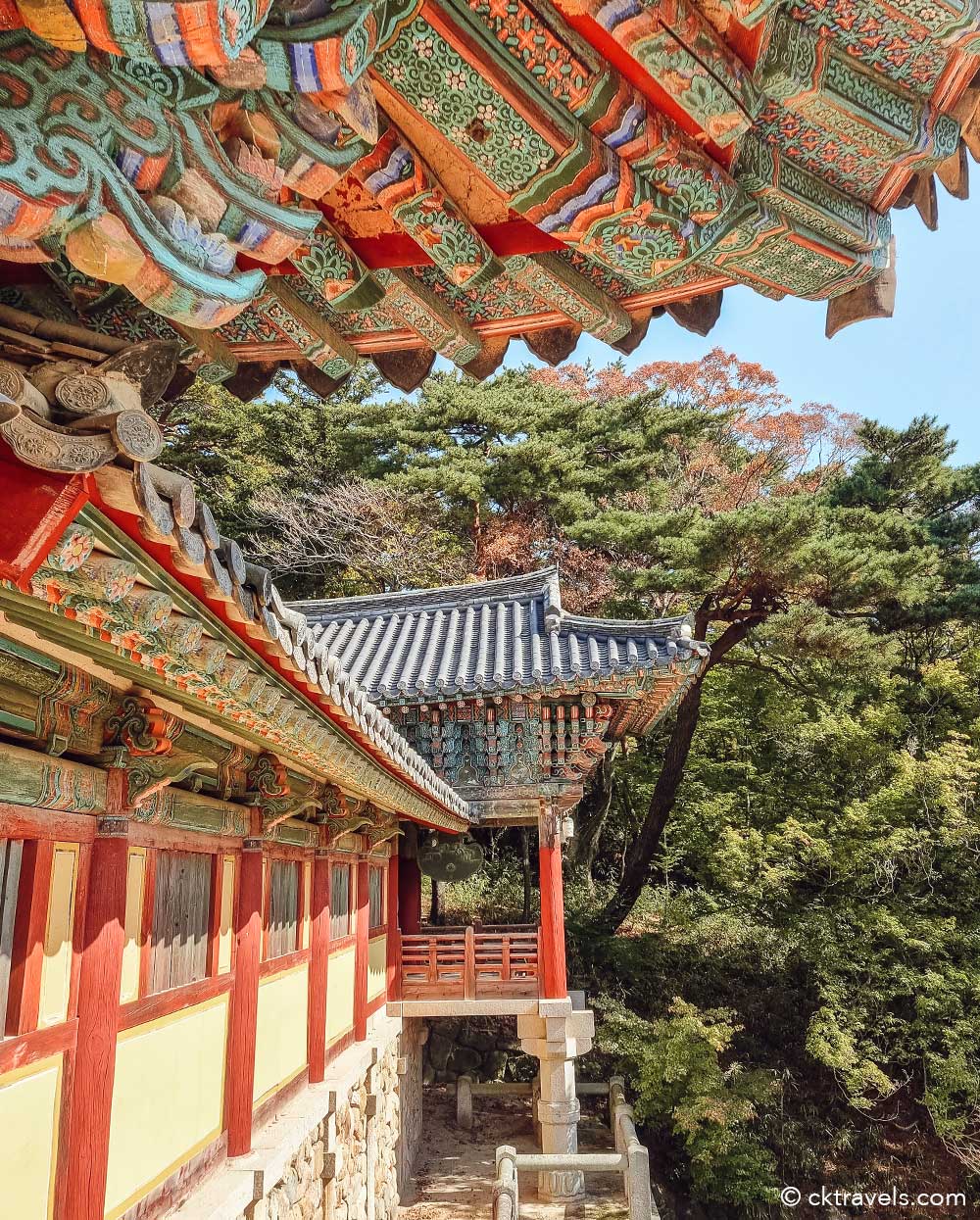
You might like – best things to do in Busan. South Korea >
Table of Contents
Getting to Bulguksa Temple from Gyeongju
Bulguksa Temple is very easy to reach from downtown Gyeongju – take buses 10 , 11 or 100 from the bus stop across the road from Gyeongju Intercity Bus Terminal or bus 700 from the Gyeongju Express Bus Terminal.
These Gyeongjui 10, 11, 100 and 700 buses also go past many other downtown areas before reaching Bulguksa Temple like Hwanglidangil or the Daereungwon Tomb Complex.
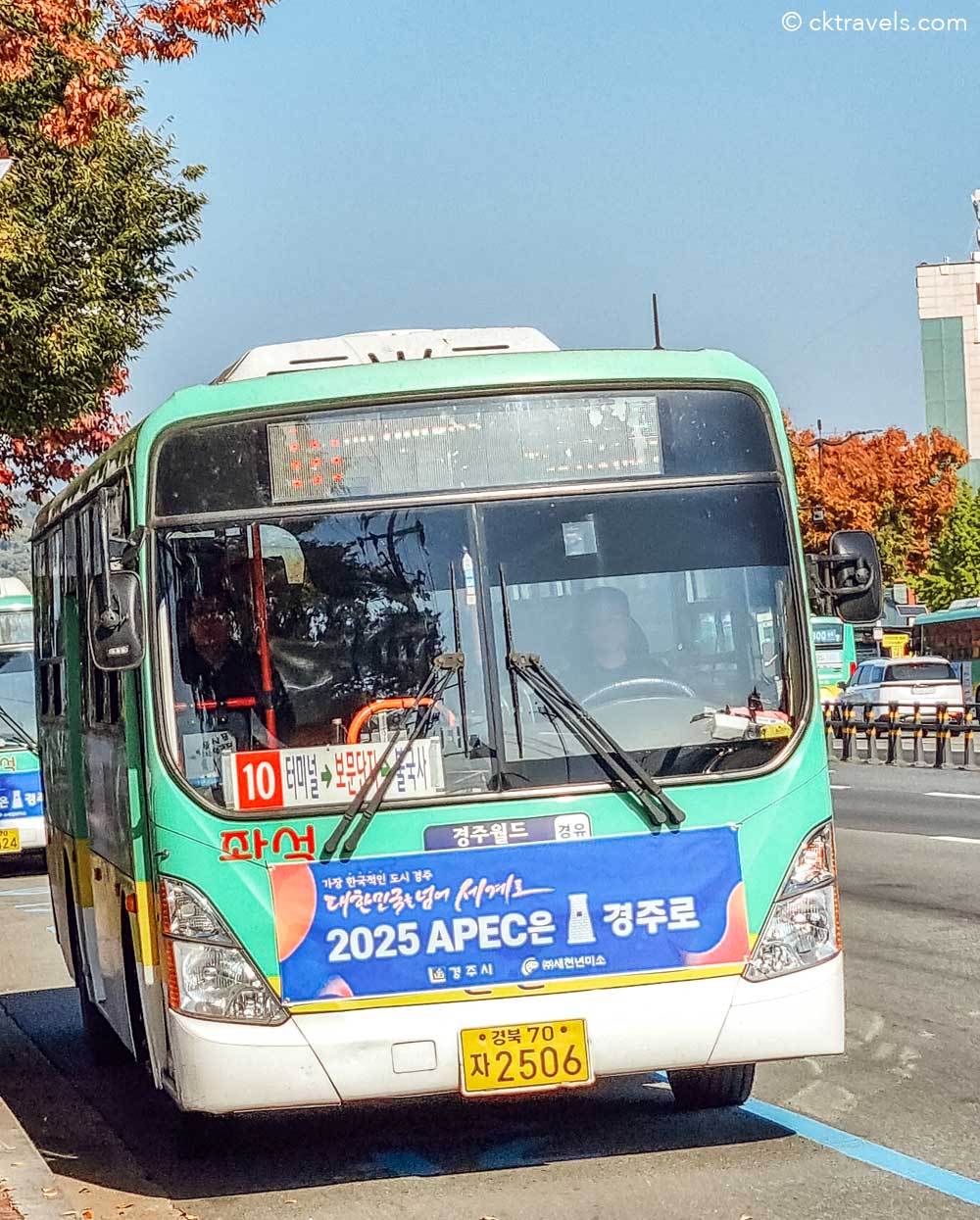
You can use money to buy your bus tickets to Bulguksa Temple but we’d recommend getting a T Money card from a station or convenience store and topping it up.
T Money cards initially cost 5000 Korean Won but last indefinitely and are very convenient to hop on and off public transport in, Gyeongju, Busan and South Korea.
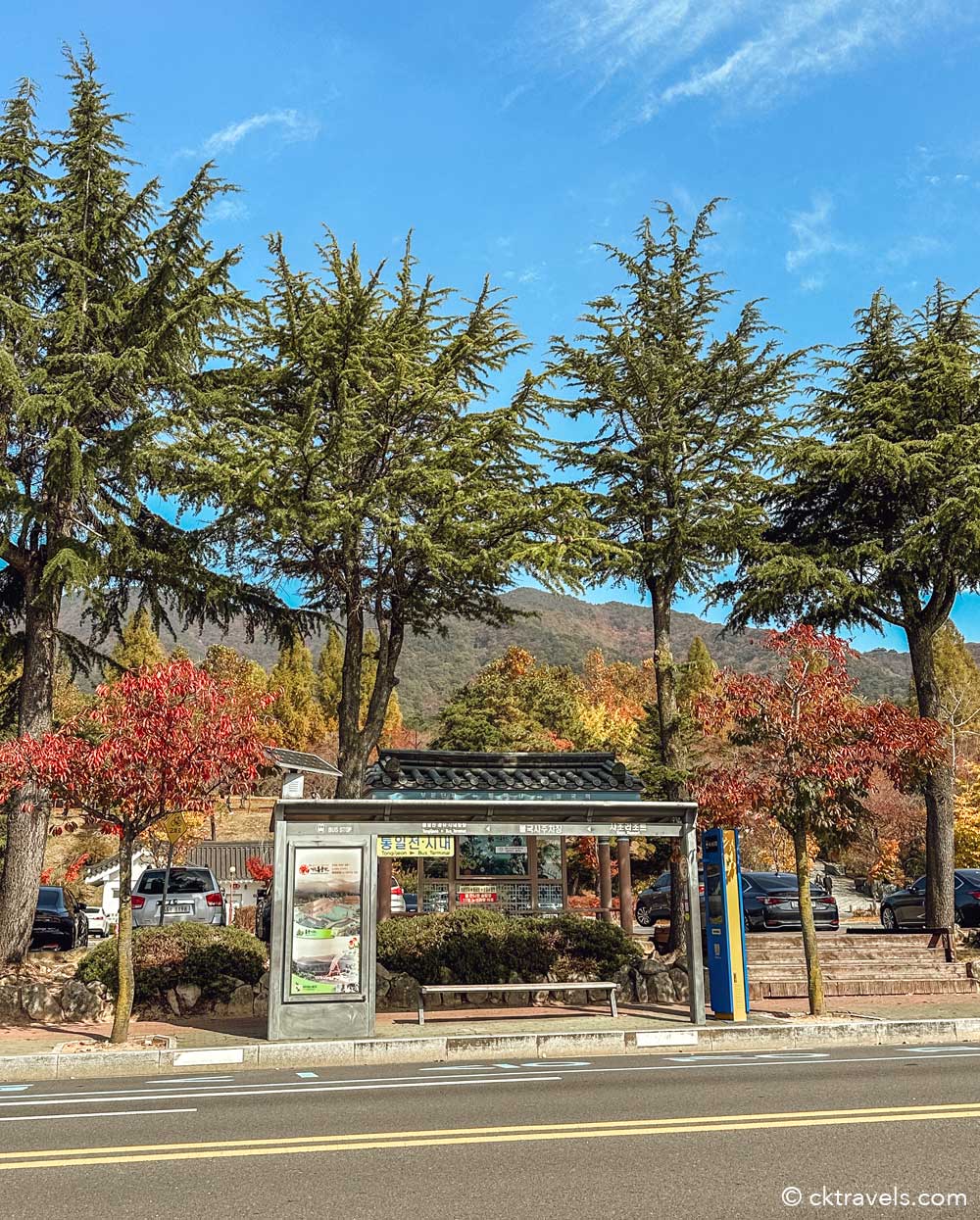
You might like – best things to do in Seoul, South Korea >
Getting to Bulguksa Temple from Busan
The bus journey from Busan Central Bus Terminal to Bulguksa Temple requires two buses – take an Intercity bus to Gyeongju from Busan central bus station to Gyeongju Intercity bus station; buses depart two to four times an hour until 10pm. We have written a guide on how to do this Busan to Gyeongju bus journey >
Then from Gyeongju Intercity bus station, take either public bus 10, 11, 100 to Bulguksa Station from the bus stop across the road; the journey from Busan bus station to Bulguksa Temple should take between 90 mins to 2 hours one way.
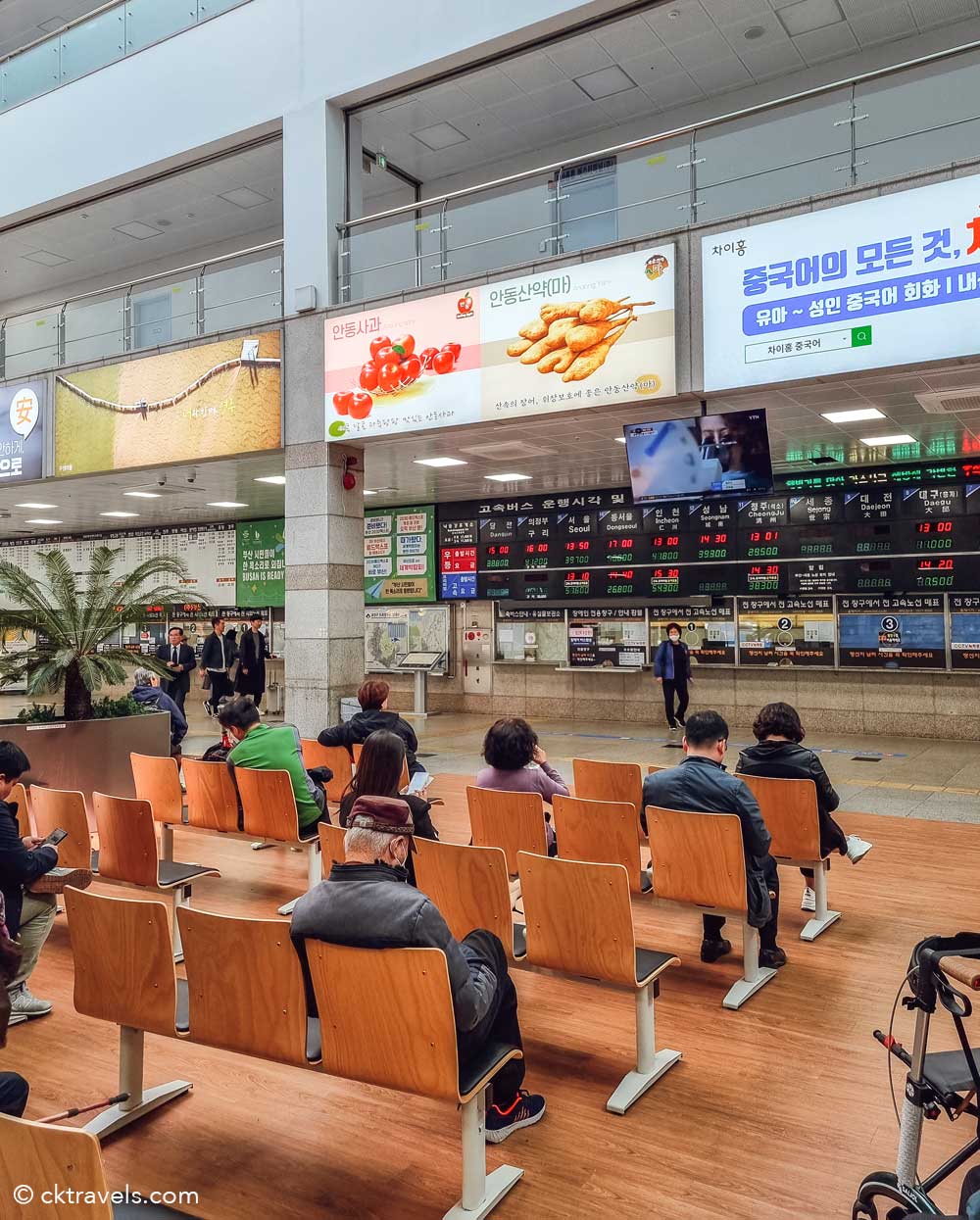
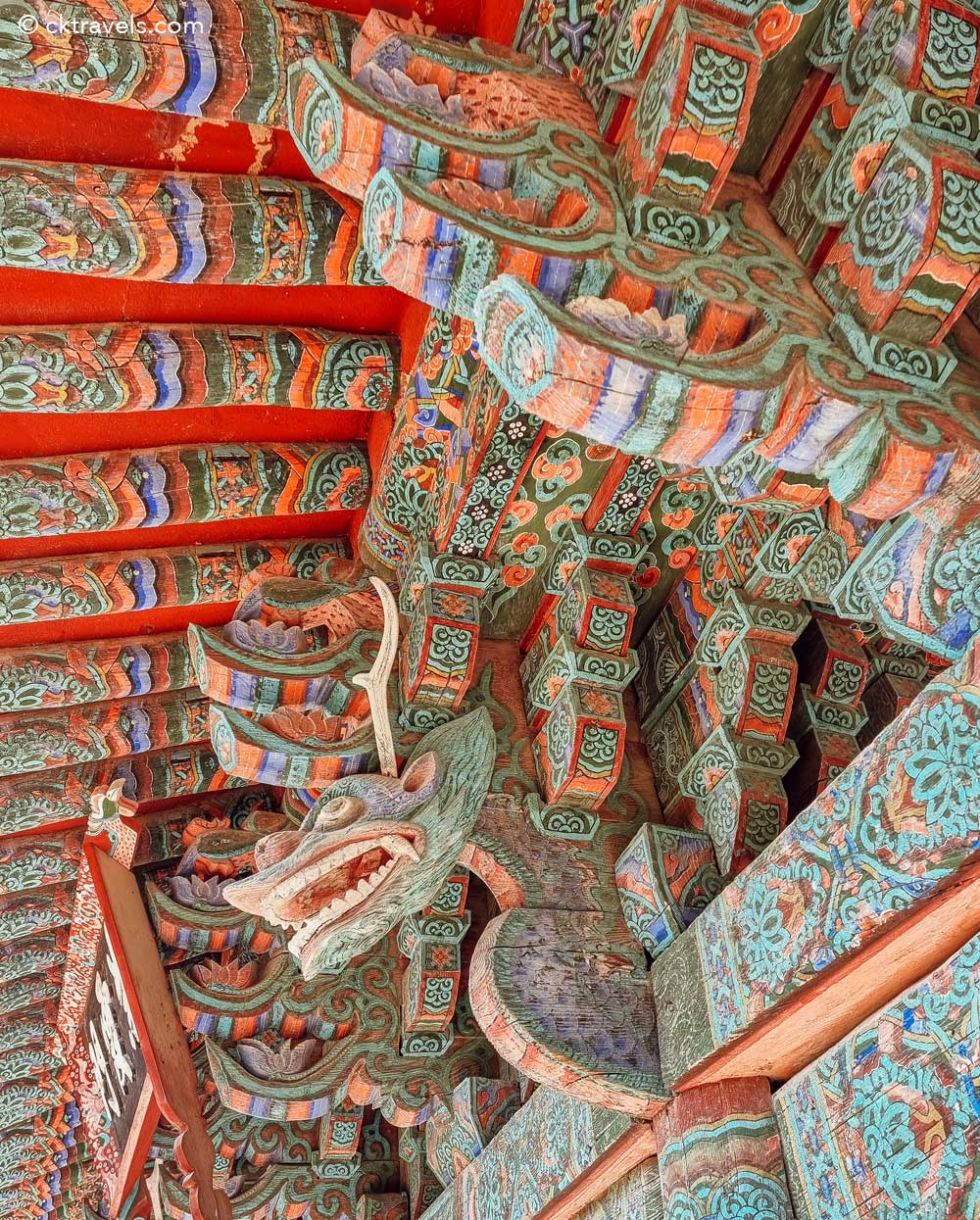
You might like – Gyeongju The Old Capital of Korea One Day Tour from Busan >
How much is it to visit Bulguksa Temple?
It is free to visit Bulguksa Temple – there is no admission charge.
Note used to be an admission charge and ticket booths are still located there, but they are now closed and unmanned.
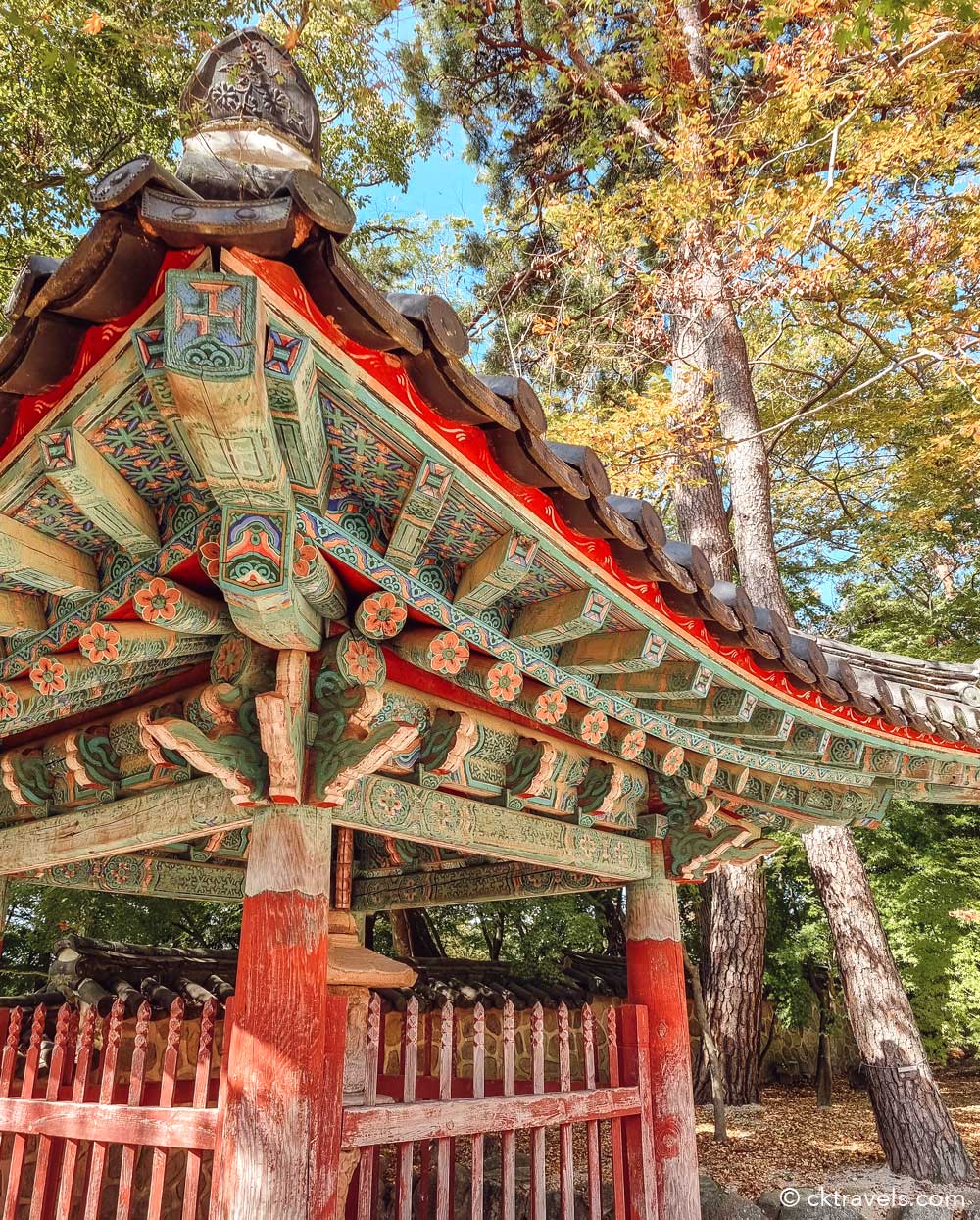
You might like – Things to do in Busan at night >
What are the Bulguksa Temple opening hours?
Bulguksa Temple is open daily from 9am until 6pm (although hours may differ on public holidays). Opening times correct as of November 2023.
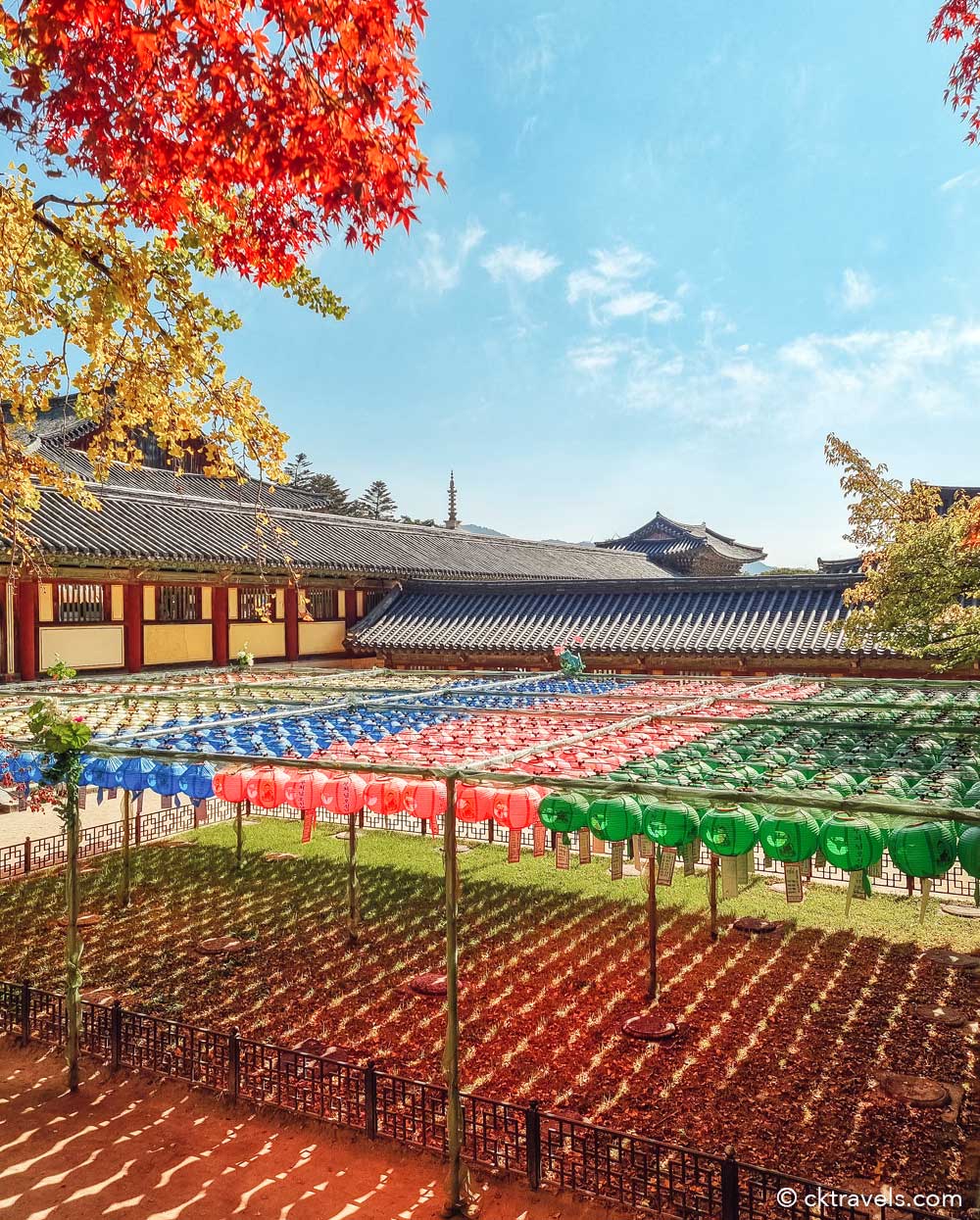
Arriving at Bulguksa Temple
If you are arriving by public bus, the walk from the bus stop to Bulguksa Temple is around a 5 minute walk up a hill.
To the right, there is a sloped road (also used by cars) and to the left, a series of stairs you can walk up to the main entrance.
Unlike a lot of temples, Bulguksa Temple is also wheelchair accessible and can be reached without any steps if you follow the slopes – wheelchair routes are clearly signposted.
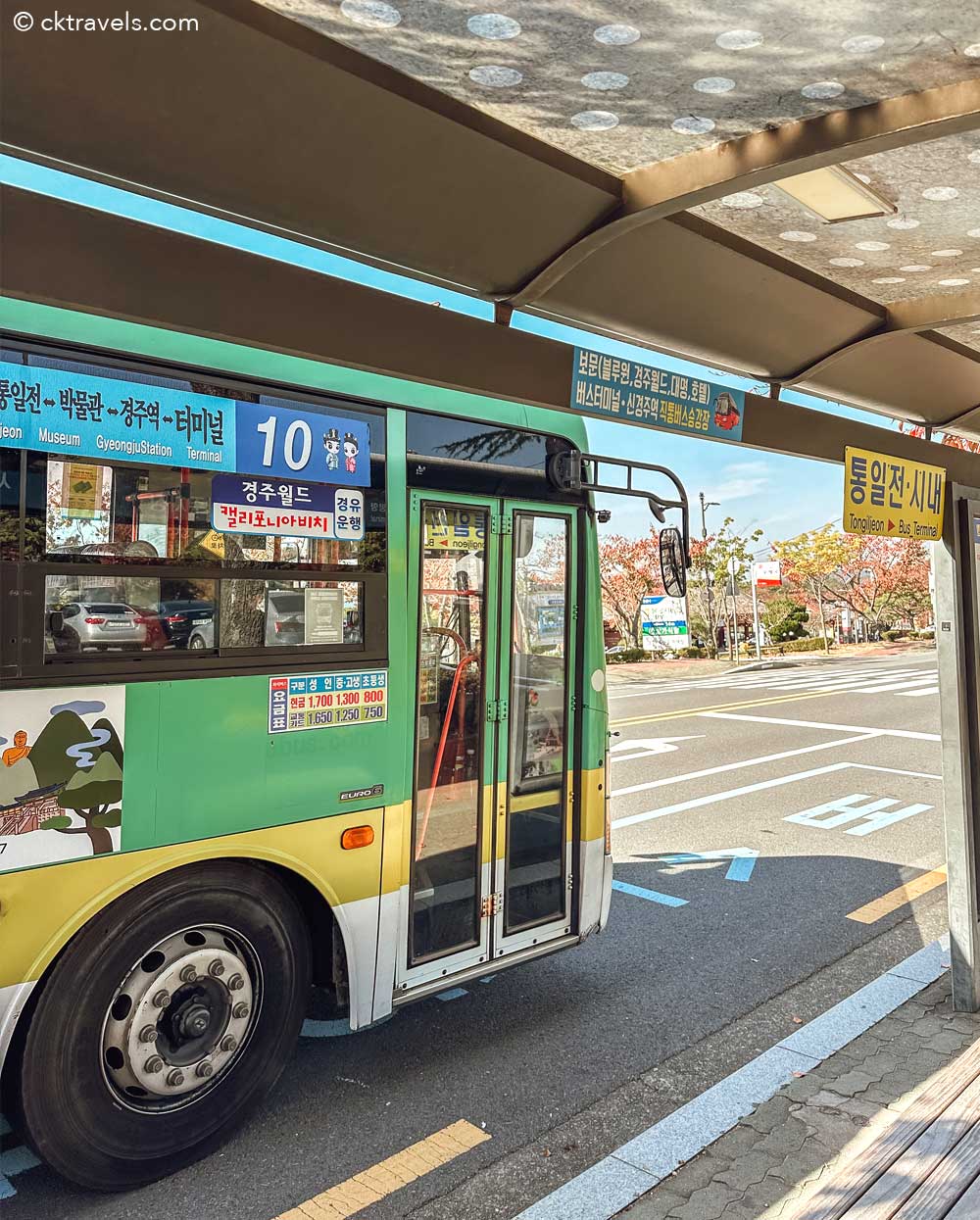
Be prepared for tourist hordes at the temple – it is a popular tour bus location (e.g. Gyeongju Golden City Tours visit here daily).
As it is free entry plus there is a huge parking lot out front – so don’t expect a tranquil temple experience (but it is still very much worth visiting).
Be sure to check out the small wooden entry hut and gates before entering the main temple site which contain huge carved wooden soldiers, who stand ‘guard’ over the temple.
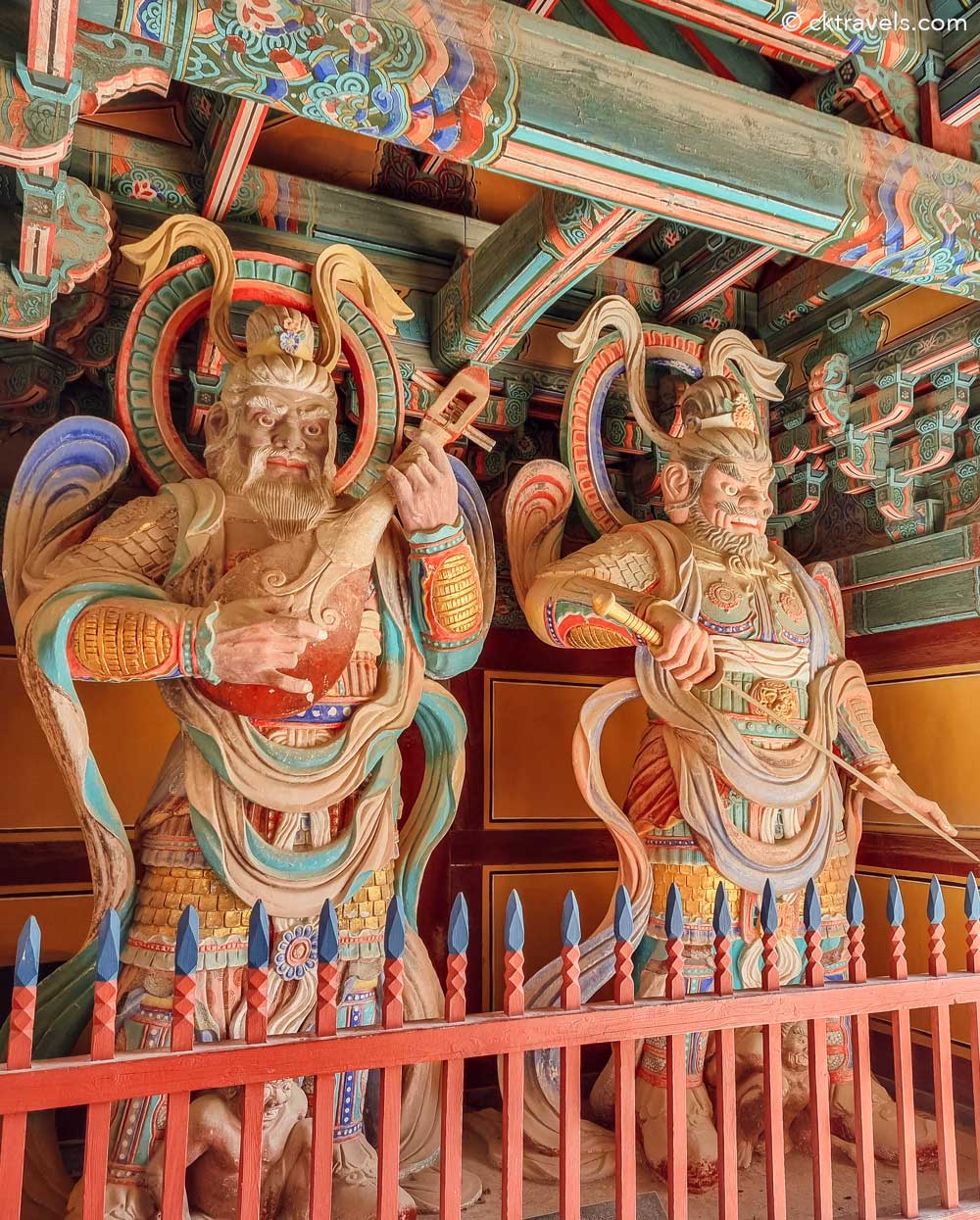
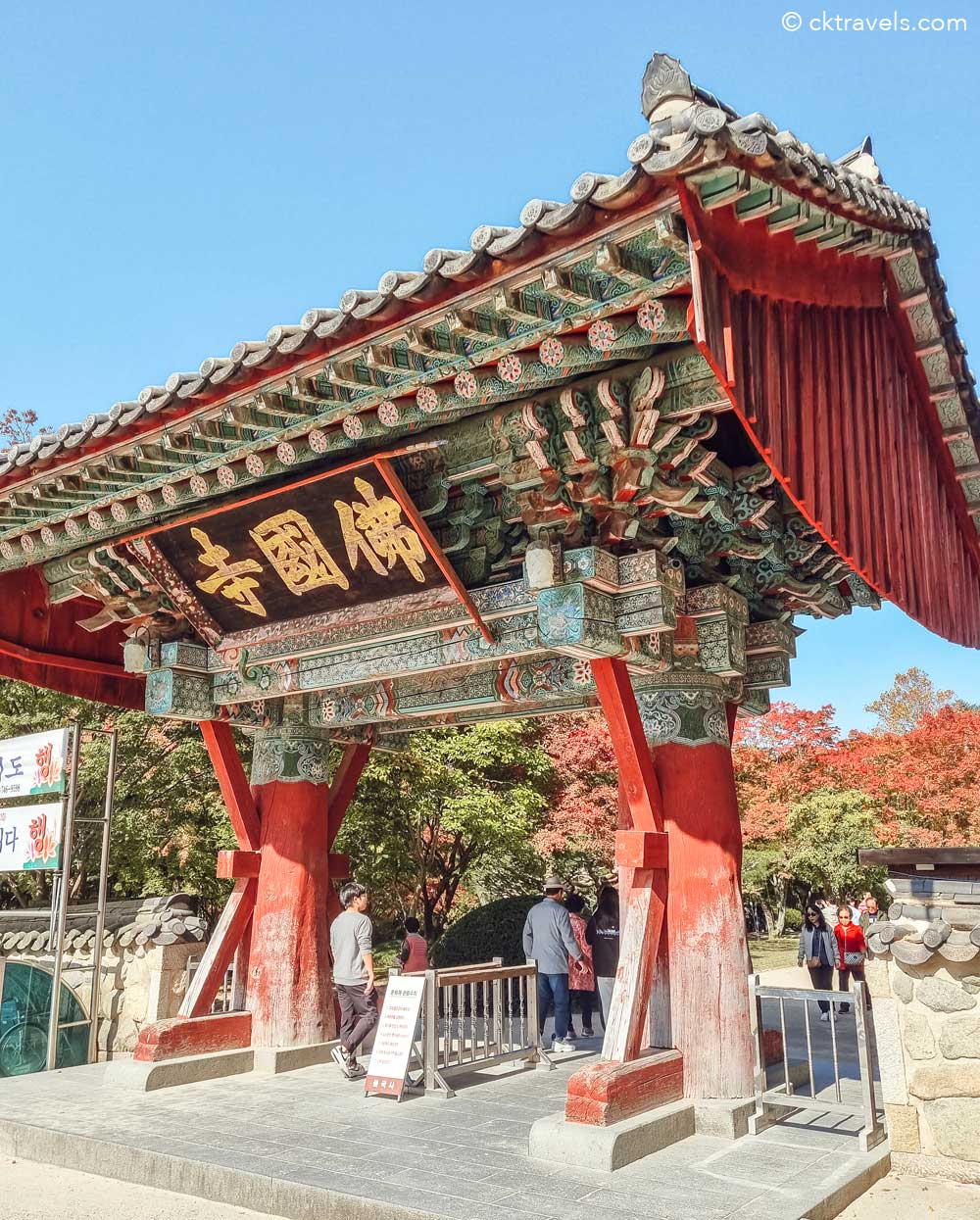
You might like – Gyeongju UNESCO World Heritage Sites and History Full-Day Tour >
History of Bulguksa Temple in Gyeongju
One of Gyeongu’s most glorious temples built upon Tohamsan Mountain, ground work began on Bulguksa Temple in 751 AD and was completed in 774 AD (although smaller religious buildings had been built previously here in the 6th century).
It is the main temple of the Jogye Order of Buddhism in Korea and contains six ‘national treasures’ including two stone Buddhas (of which photography is not allowed).
Many of the original wooden buildings were burned down in the successive wars – many periods of restoration and rebuilding have been undertaken over the decades.
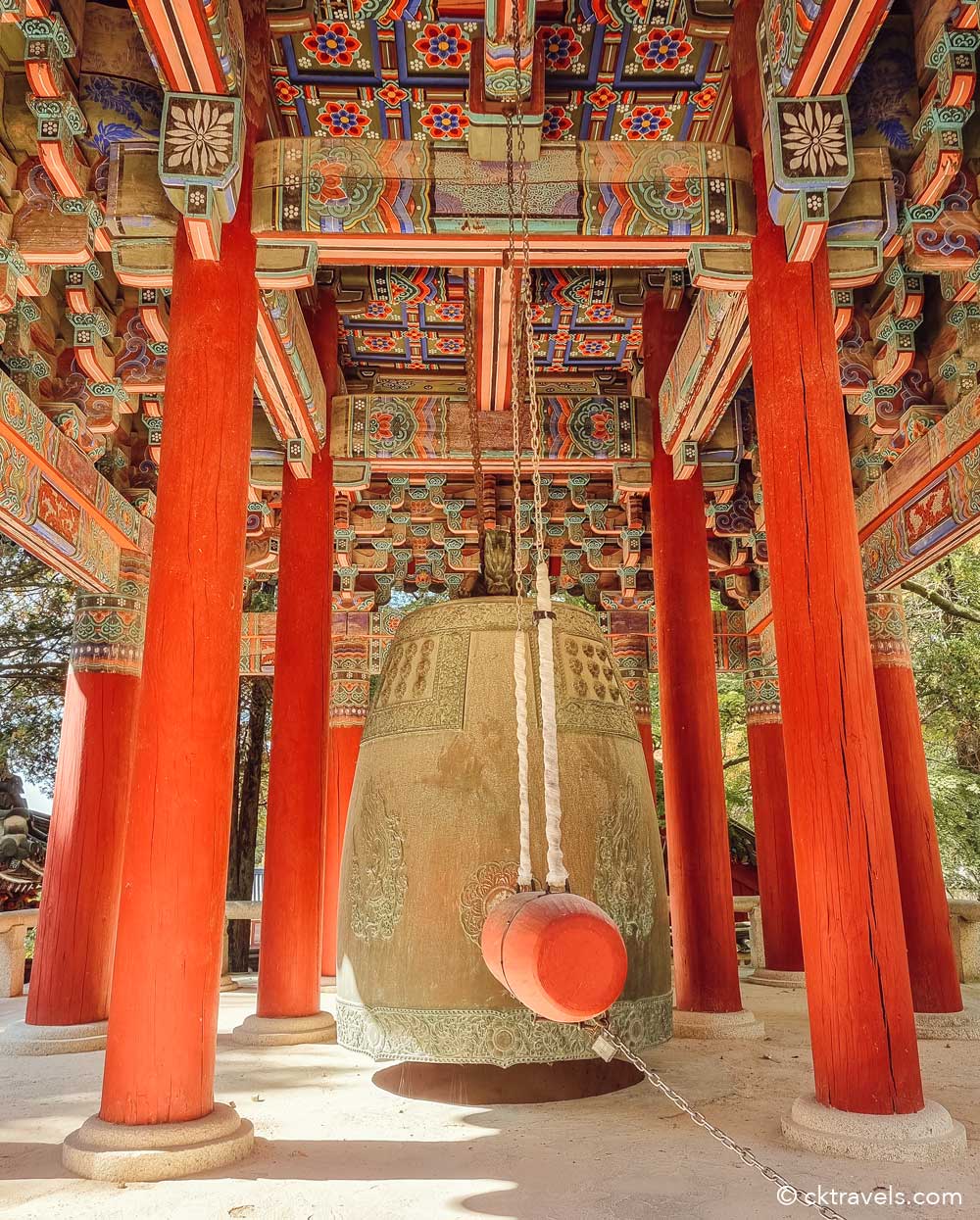
You might like – Gyeongju Private Tour : Uncover the Eternal Beauty >
Main features of Bulguksa Temple
There are several main areas and features to look out for whilst exploring Bulguksa Temple.
Cheongungyo Bridge / Baegungyo Bridge
The first main entrance and stairway (now closed) to the temple, this is also one of the most impressive edifices on the whole site (and a popular group photo site).
The staircases were built in the mid 8th century – the upper section is referred to Cheongungyo and the lower section as Baegungyo Bridge. Whilst these staircases are now sealed off, you can access the viewing platforms at the top from inside Bulguksa temple.
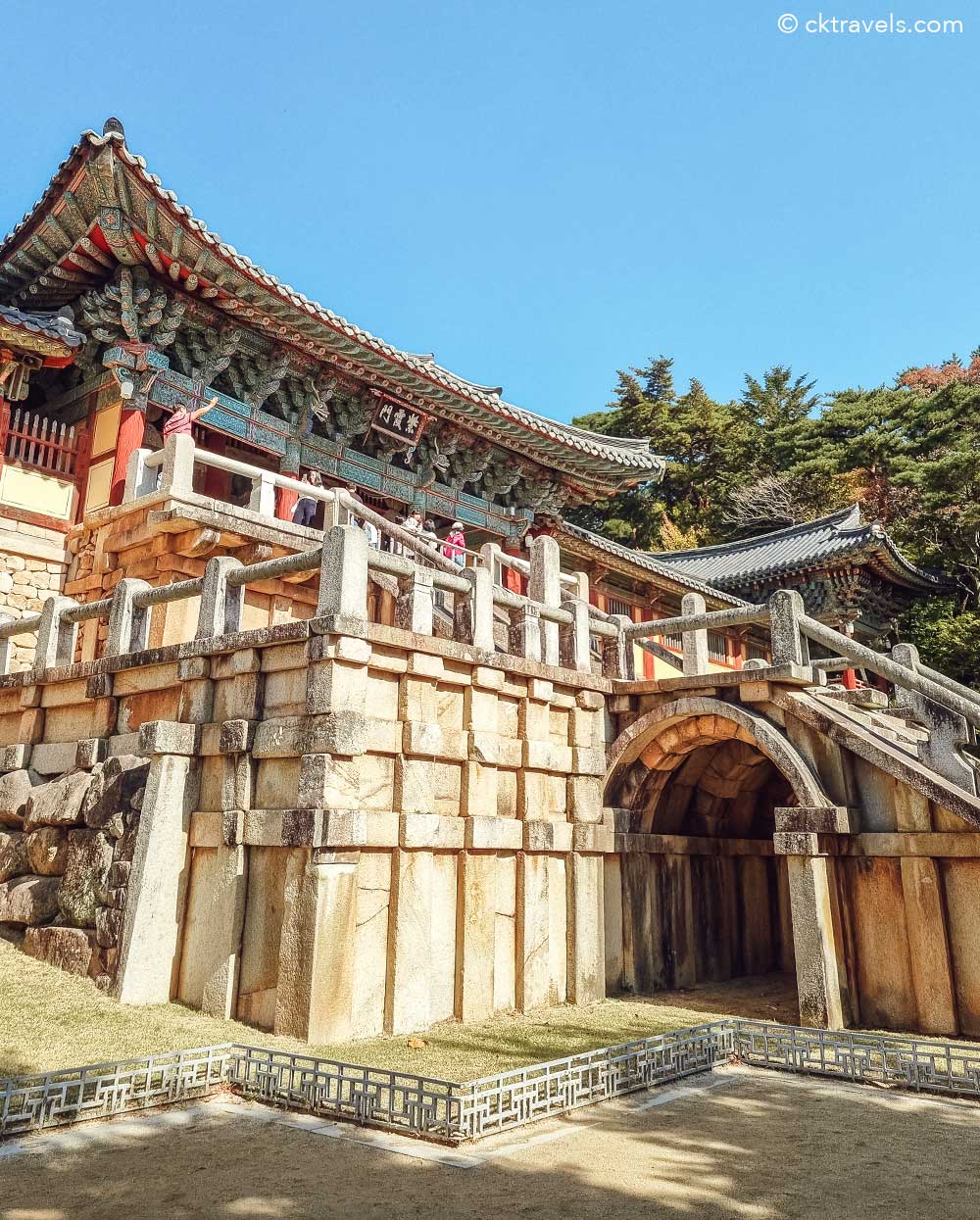
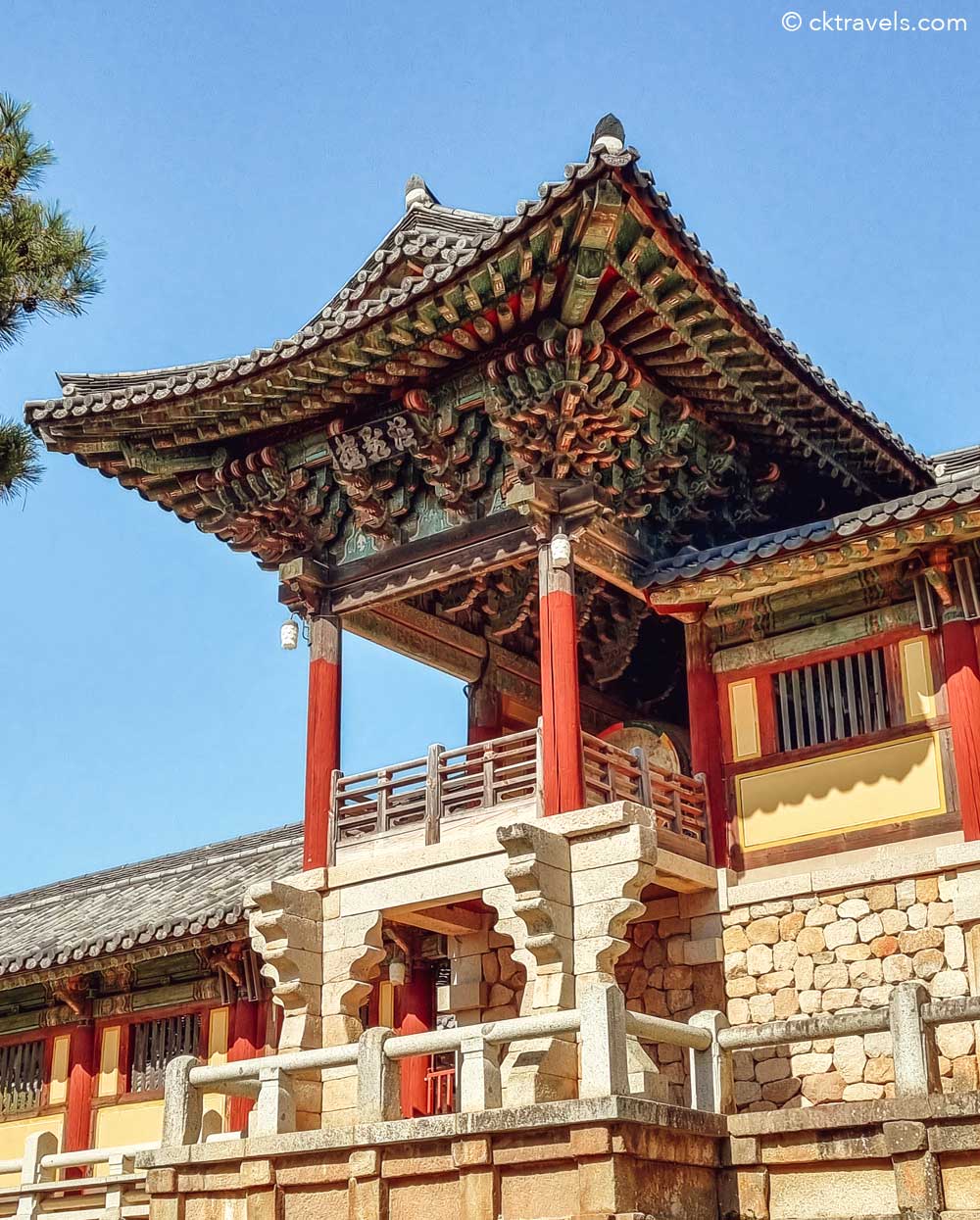
Join our New 2024 Facebook South Korea Travel Planning and Tips Group!
Need help with your itinerary or have any South Korea related questions? Head on over to our Facebook group!
Click here to join our group >
Beonmyeongnu Pavilion / Jwagyeongnu Pavilion
The main temple area, Beonmyeongnu Pavilion is actually a replica reconstructed after the old one perished.
For us, this was one of the most beautiful areas to explore – our visit also coincided with colourful lanterns being hung up.
Well-wishers could purchase lanterns with and personalise them with their own messages before getting some step ladders to hang them up.
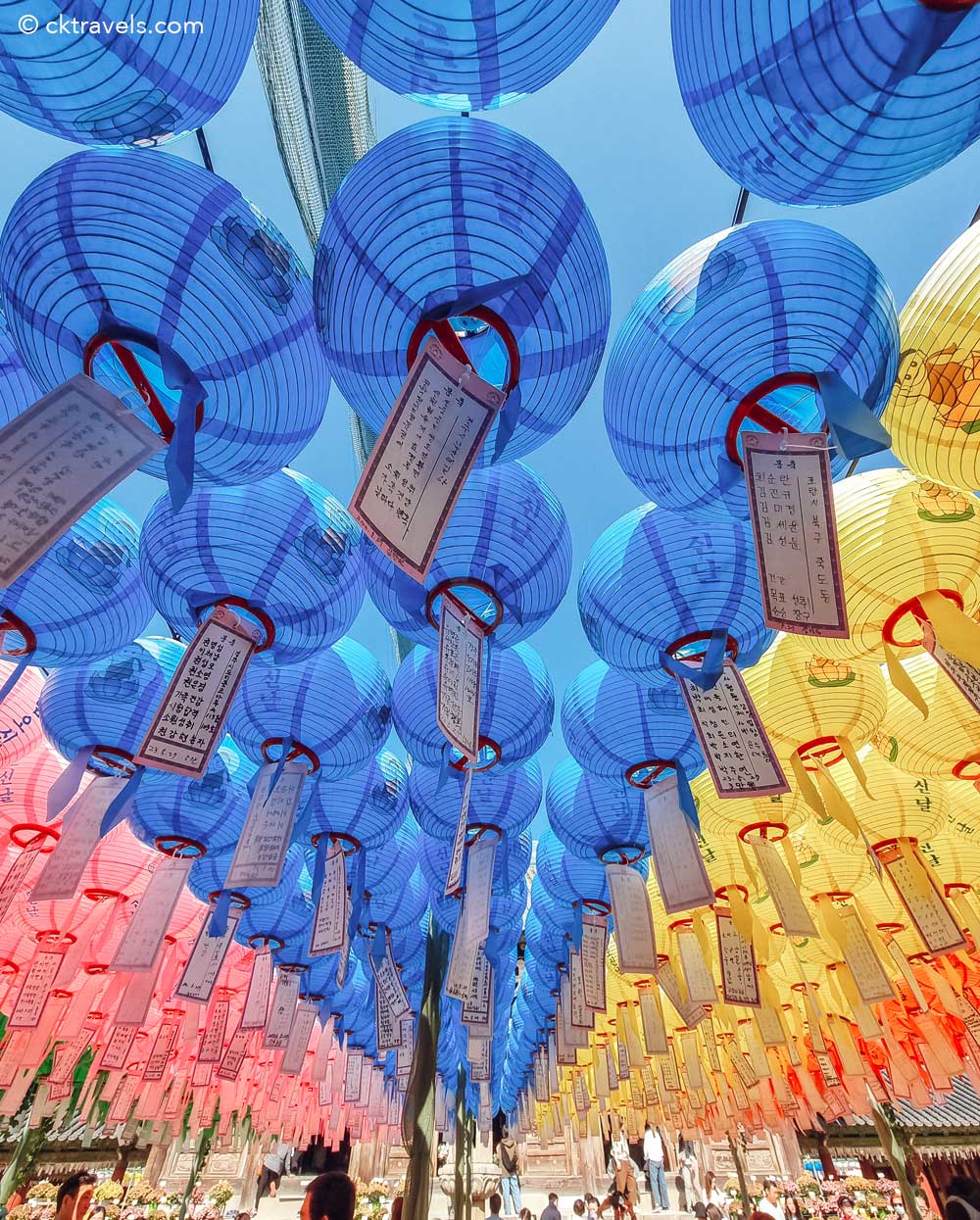
You might like – Things to do in Seoul at night >
Daeungjeon Hall
This is the main hall at Bulguksa Temple (first built in the late 7th century) where the Sakamuni Buddha is enshrined and where religious artefacts and paintings are stored – the two pagodas stand in front of this hall (more on these later).
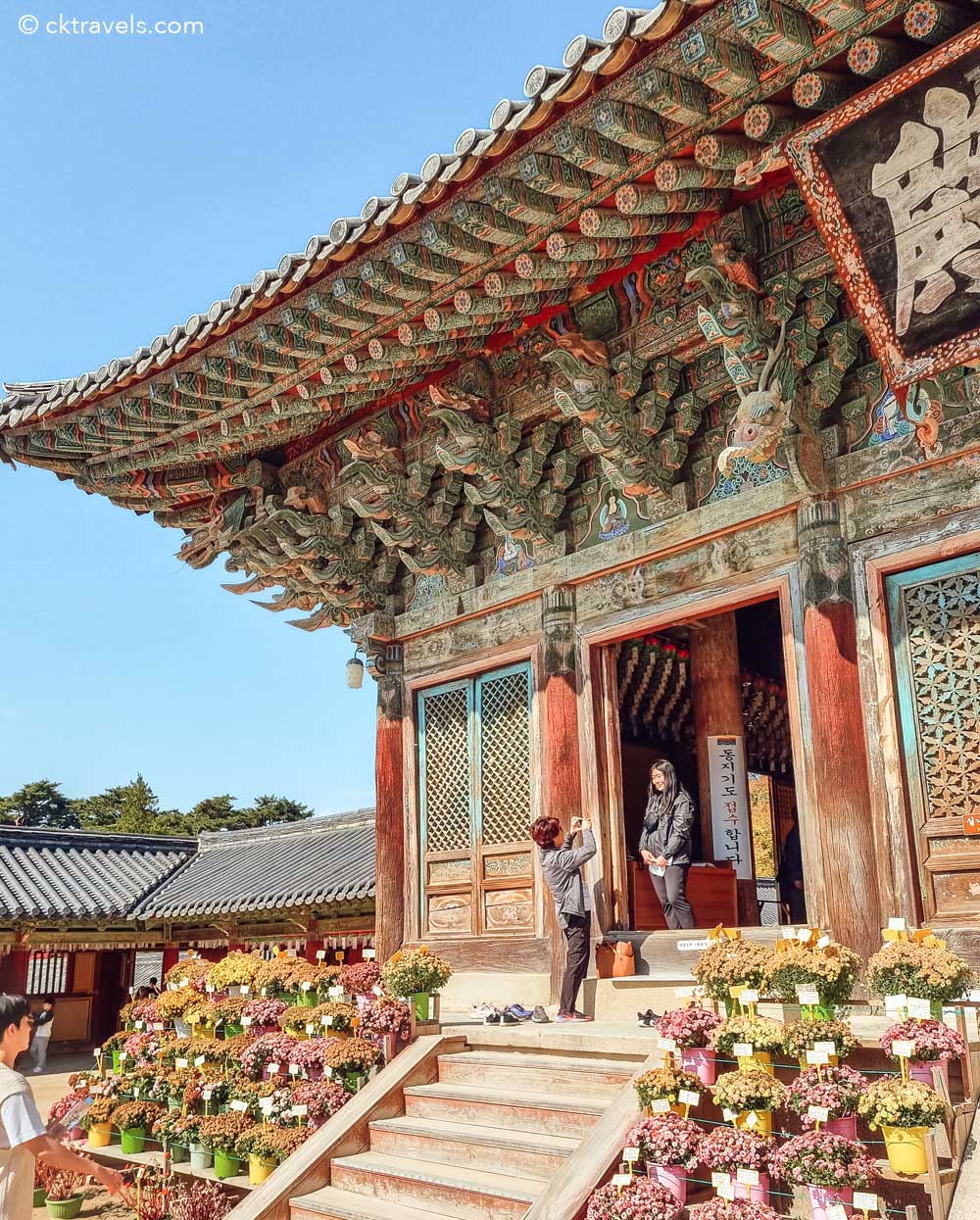
Museoljeon Hall
Behind the main Daeungjeon hall, you find Museoljeon, one of the most historic buildings here. Museoljeon, is known as the ‘the Hall of No Words’ based on the Buddhist edict that important teachings cannot be just learned through words.
This is the first building of Bulguksa Temple for lecturing of the Lotus Sutra by order of King Munmu of Silla.
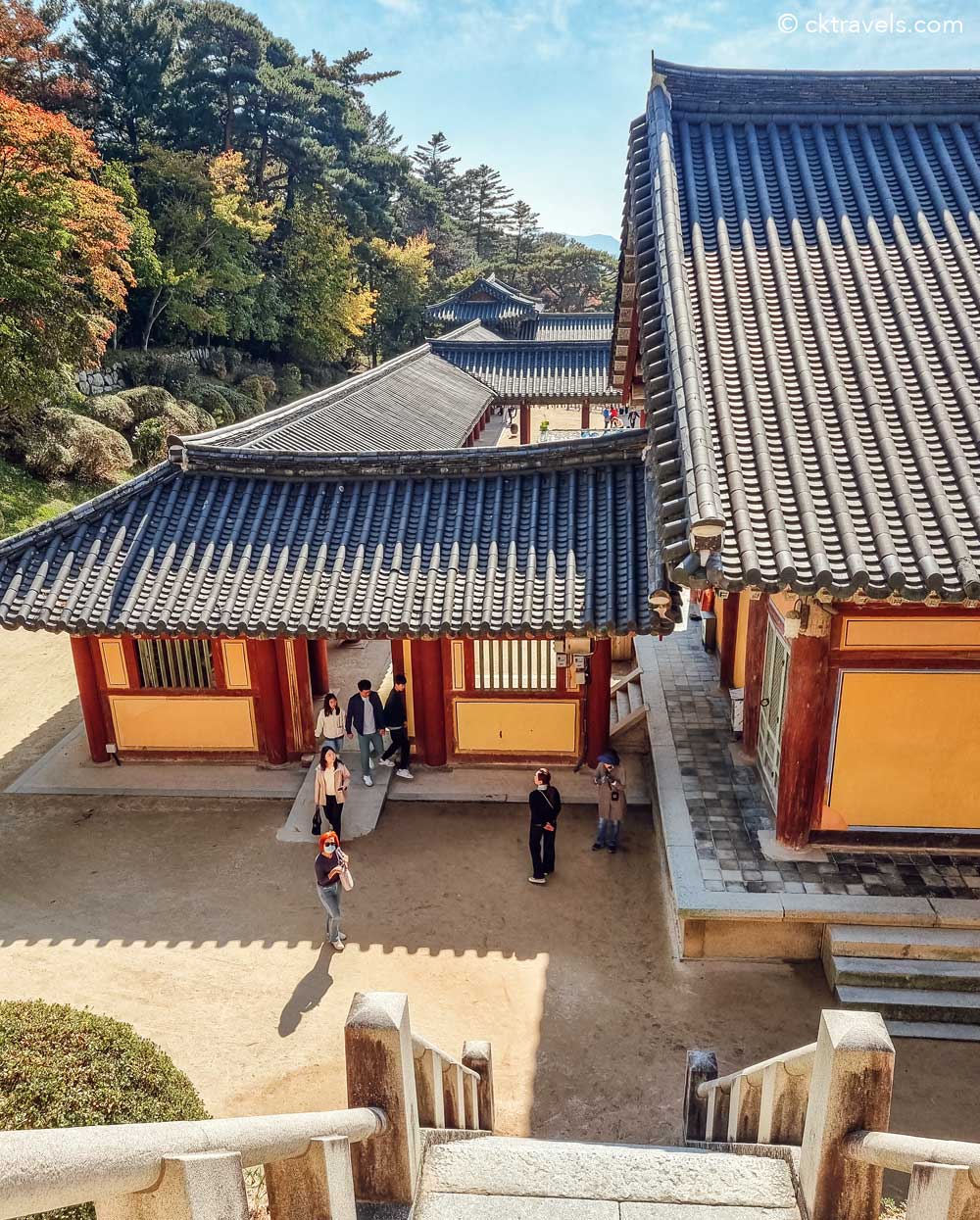
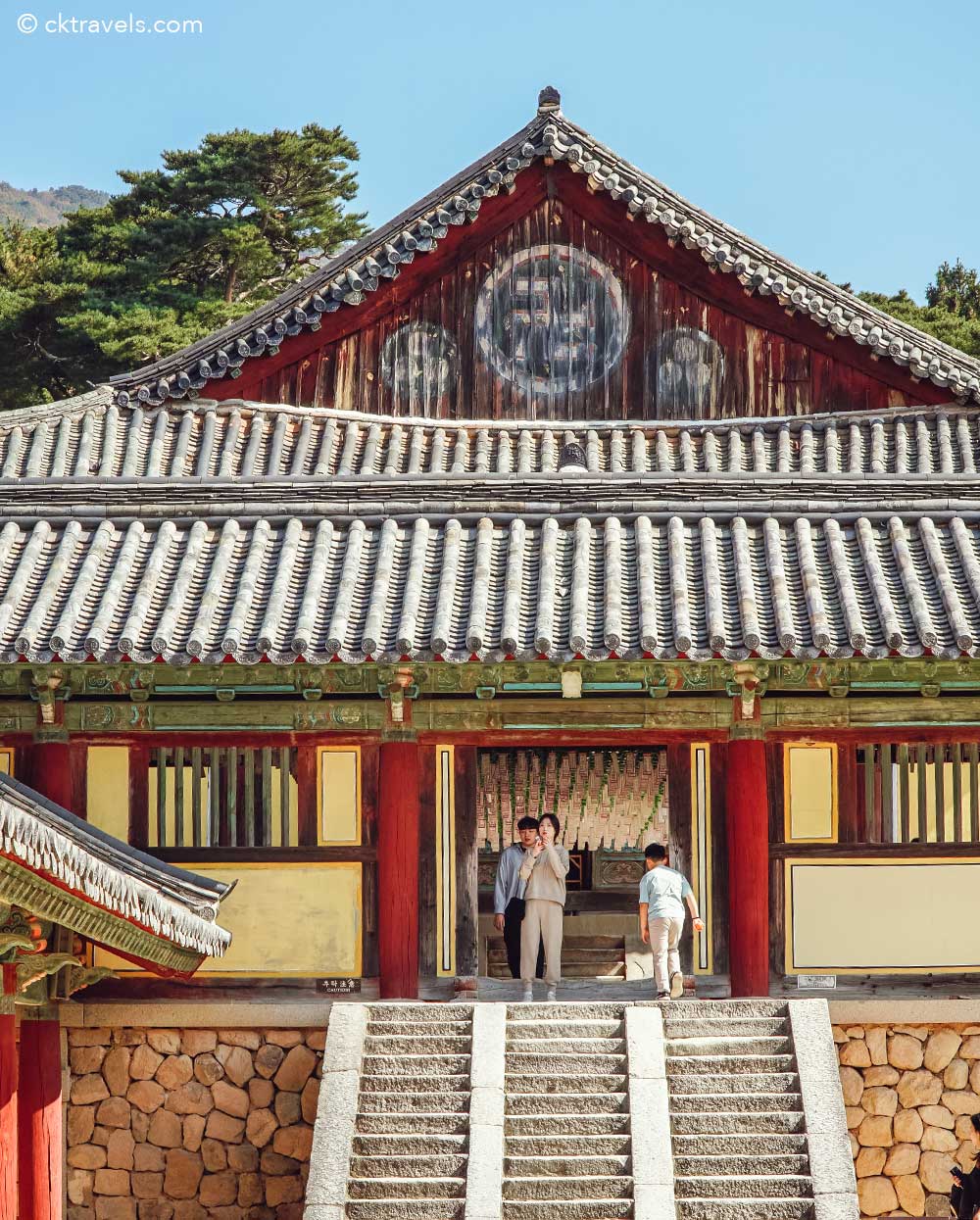
You might like – things to do in Jeju Island, South Korea >
Bulguksa Temple gardens and grounds
We were really impressed by the setting at Bulguksa Temple – there are several gardens and small lakes / bridges plus a small sculpture garden.
We were lucky enough to visit during the early fall / autumn colours (late October) so many of the trees within and around the walls were turning incredible red and orange hues.
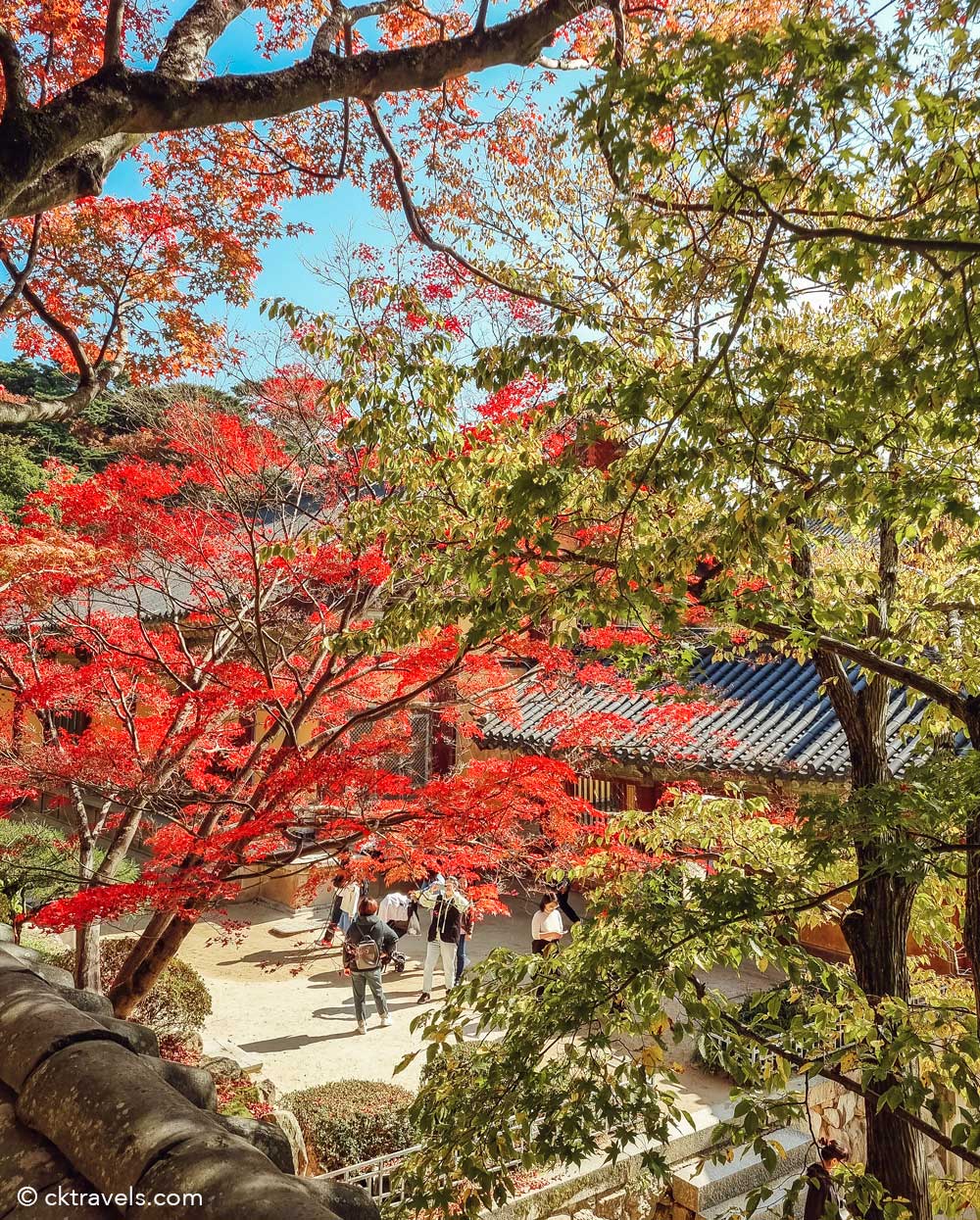
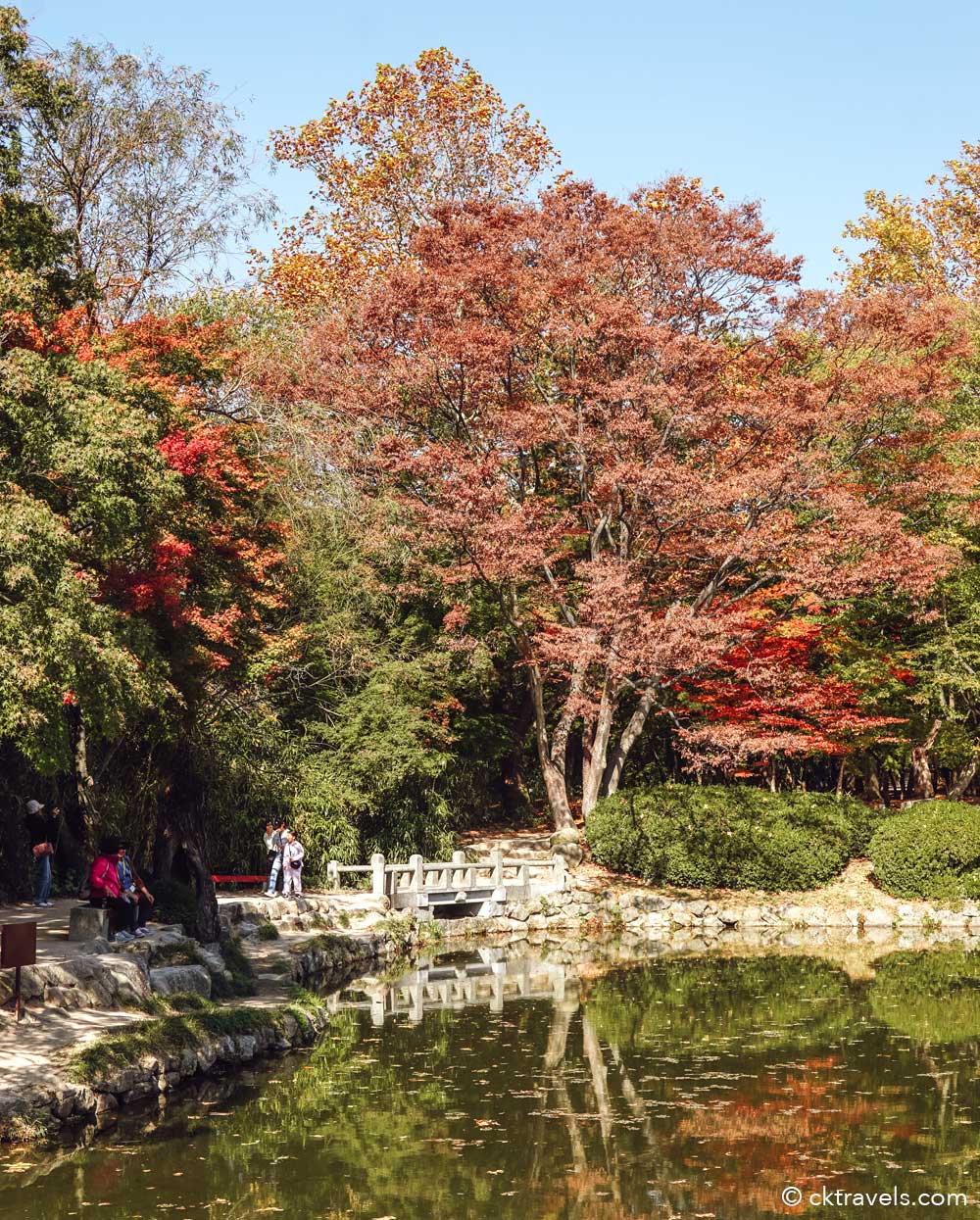
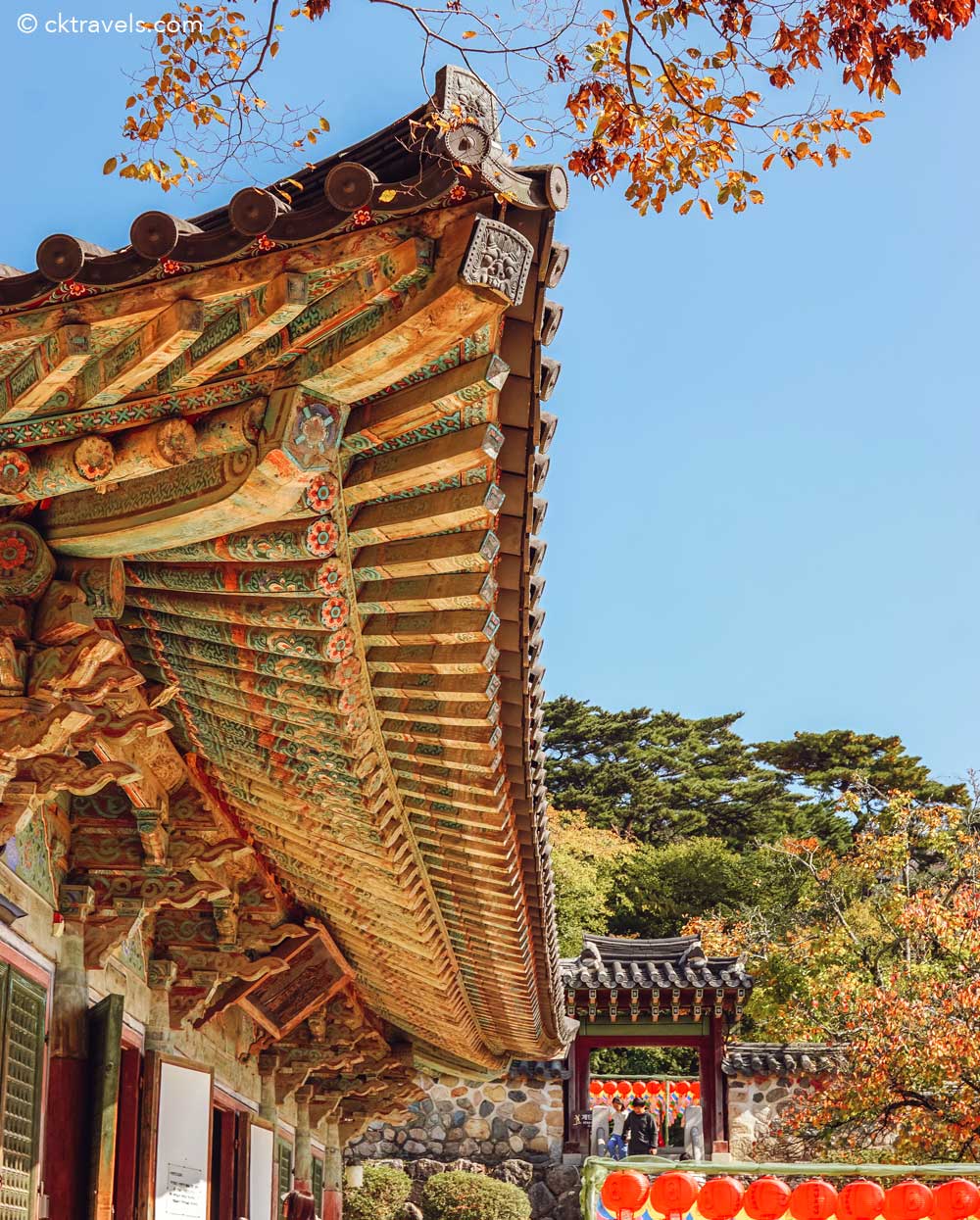
Pagodas
There are two pagodas – the Dabotap pagoda (which is reproduced on the Korean 10 Won coin) and Seokgatap pagodas, which date back many centuries (although have had much restoration over the years).
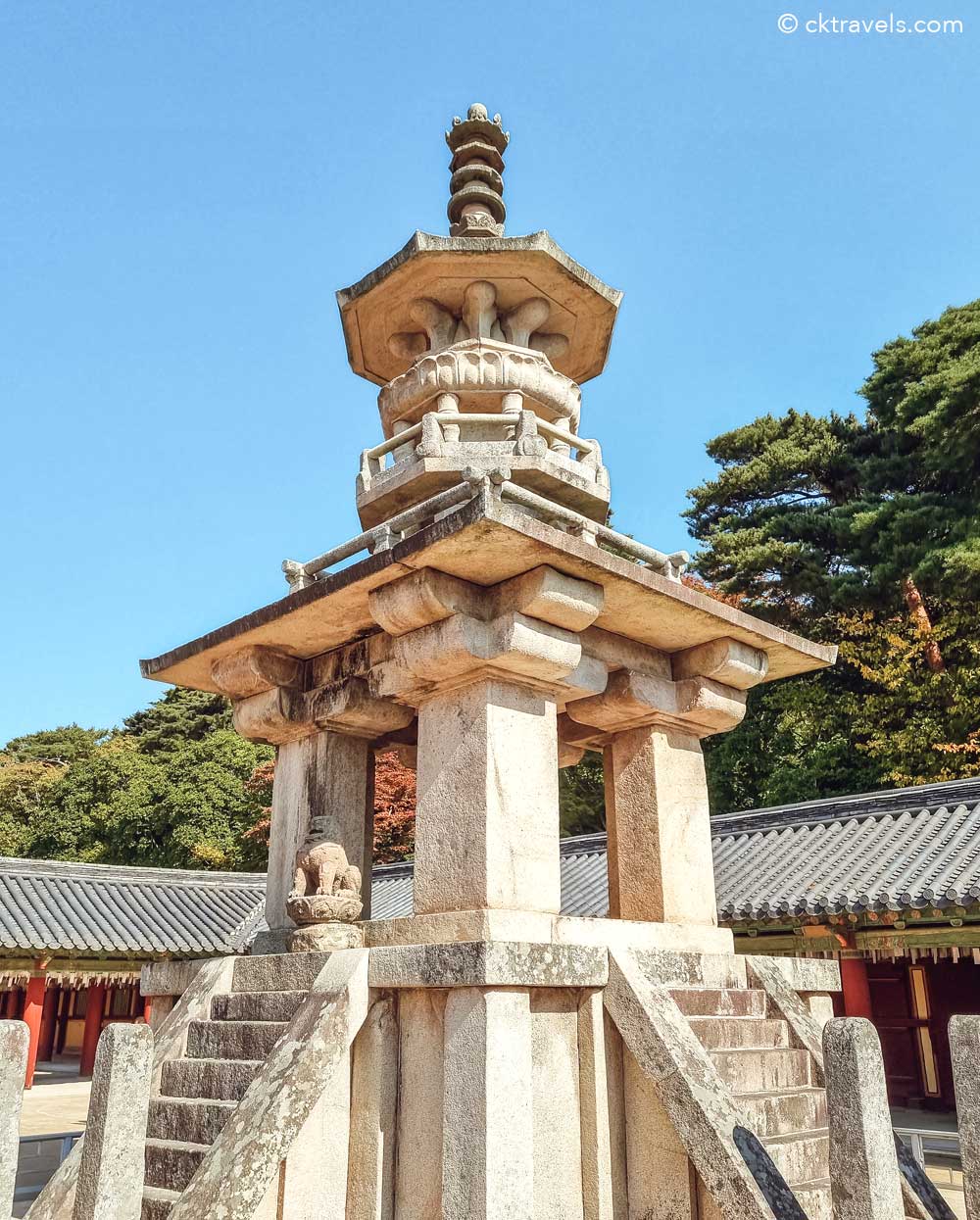
You might like – Guide to using the Visit Busan pass, 30+ attractions for one low price >
Food and drink
There are lots of food and drink options at the temple. As you arrive at the temple, there are around 15 to 20 food vendors selling hot foods like roasted chestnuts and Oden stalls selling fishcakes.
Inside the grounds, there is also a couple of cute cafes in the shadow of the temple and surrounding teas selling tea, coffee, ice-cream and other snacks. The setting is rather sublime with an outdoor veranda looking out towards the bell tower.
Vending machines are also dotted around the site selling cold water, soft drinks and iced coffee.
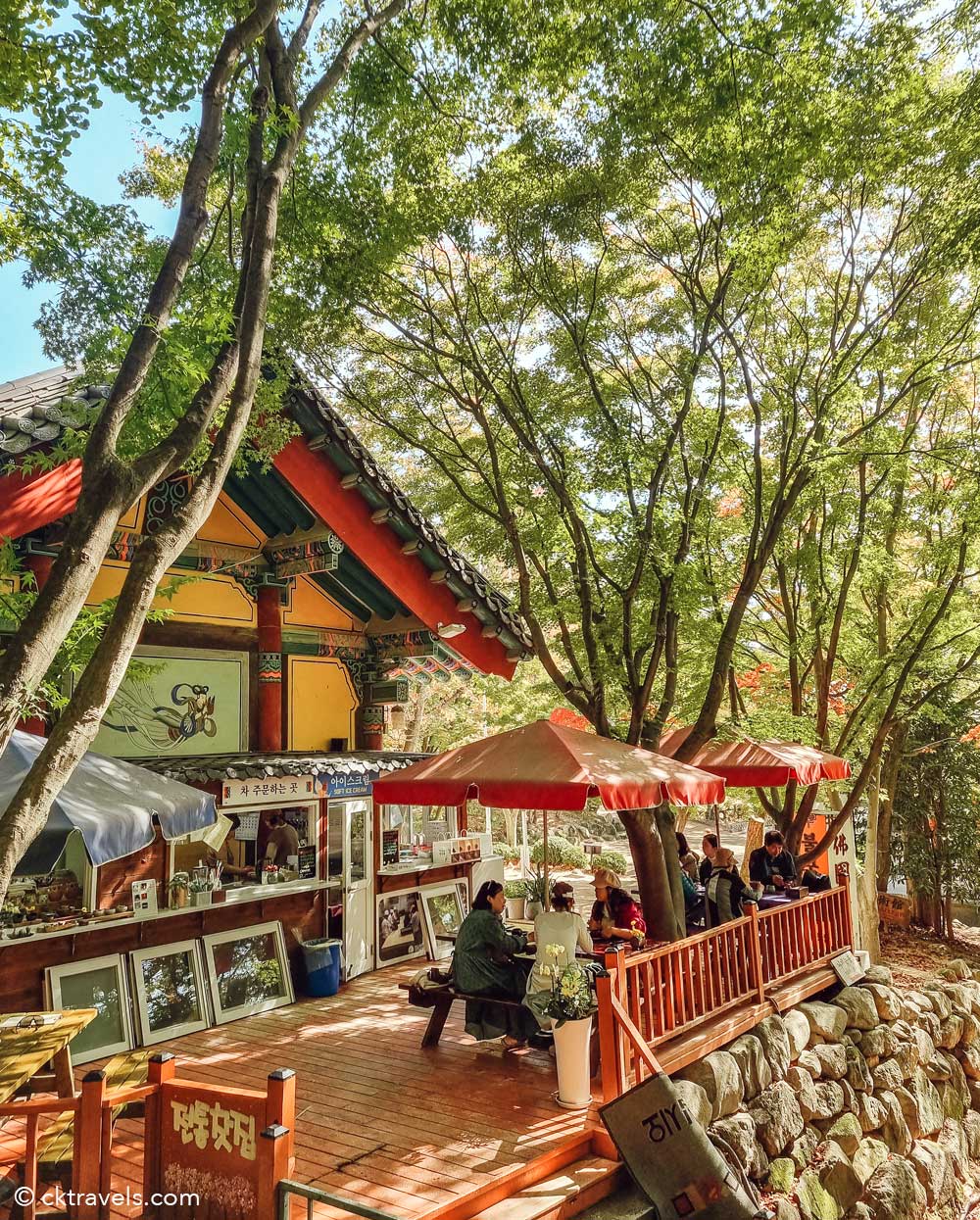
You might like – The best South Korean street food to try >
Bulguksa Temple tourist souvenirs and gift shops
There are a couple of areas that have gift shops (although they mainly sell religious artefacts as opposed to keyrings and magnets).
The first gift shops can be found by the main entrance at Cheongungyo Bridge / Baegungyo Bridge – one sells artefacts, the other inscribed tiles. Another set of gift shops can be found by the temple cafe near to the bell tower.
Korean Temple etiquette
Please remember to follow the Korean Temple etiquette and wear loose fitting clothes, nothing too revealing and to take off your shoes when requested to do so.
Signs across the site ask you to not take pictures of the Buddhas or worshippers and monks (although we didn’t see any of the latter) – please be respectful when visiting the temple.
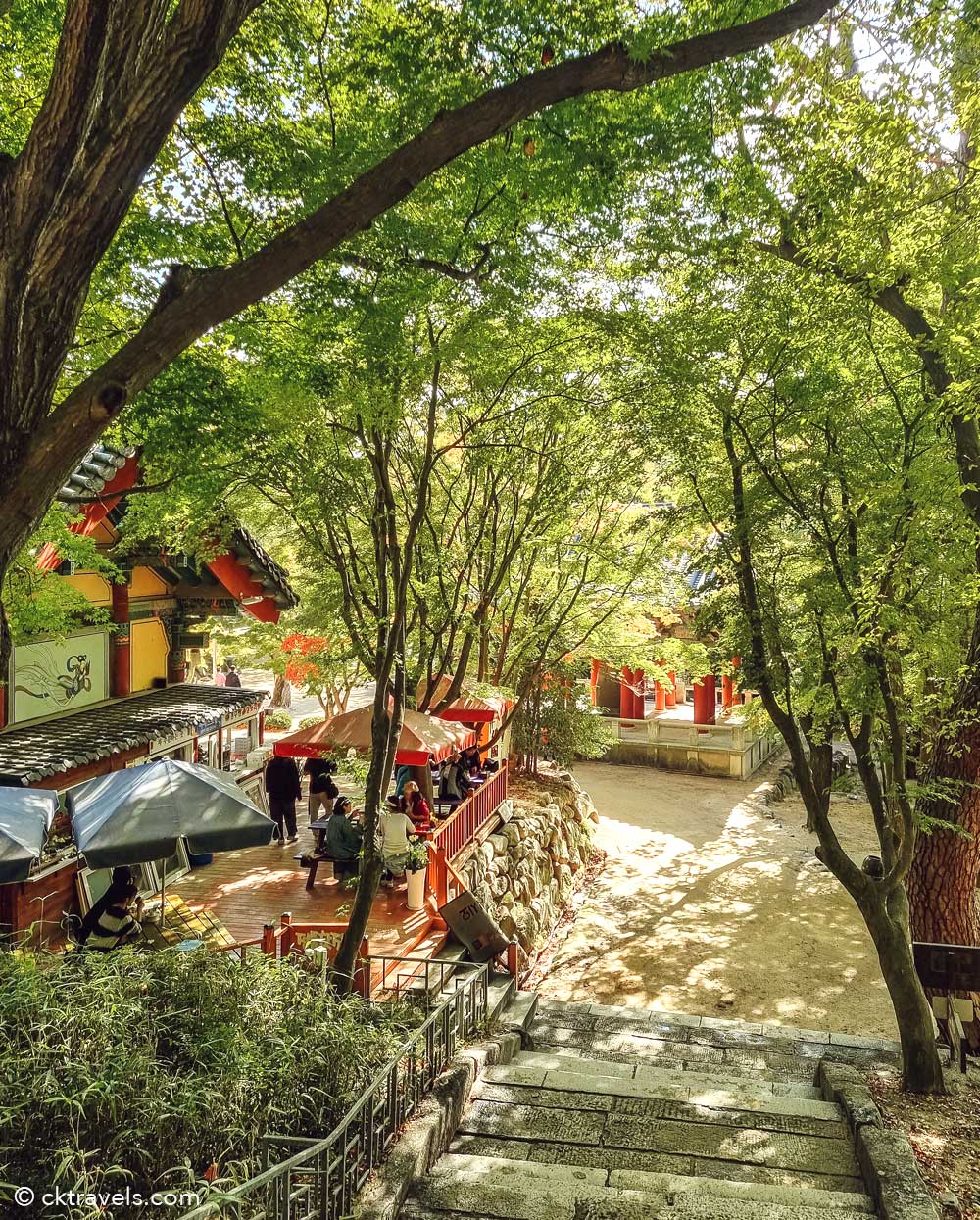
Bulguksa Temple stay
There are opportunities to stay at Bulguksa Temple as part of a temple stay. When you first approach the main entrance to the temple, there is a small kiosk entitled ‘Bulguksa Temple Stay’ that can provide more information. Note that the actual stay location is a short drive from the temple.
The Temple stay at Bulguksa Temple is open to travellers and locals who want to learn more about Buddhism and the Silla Dynasty and meditate within the grounds of Bulguksa Temple.
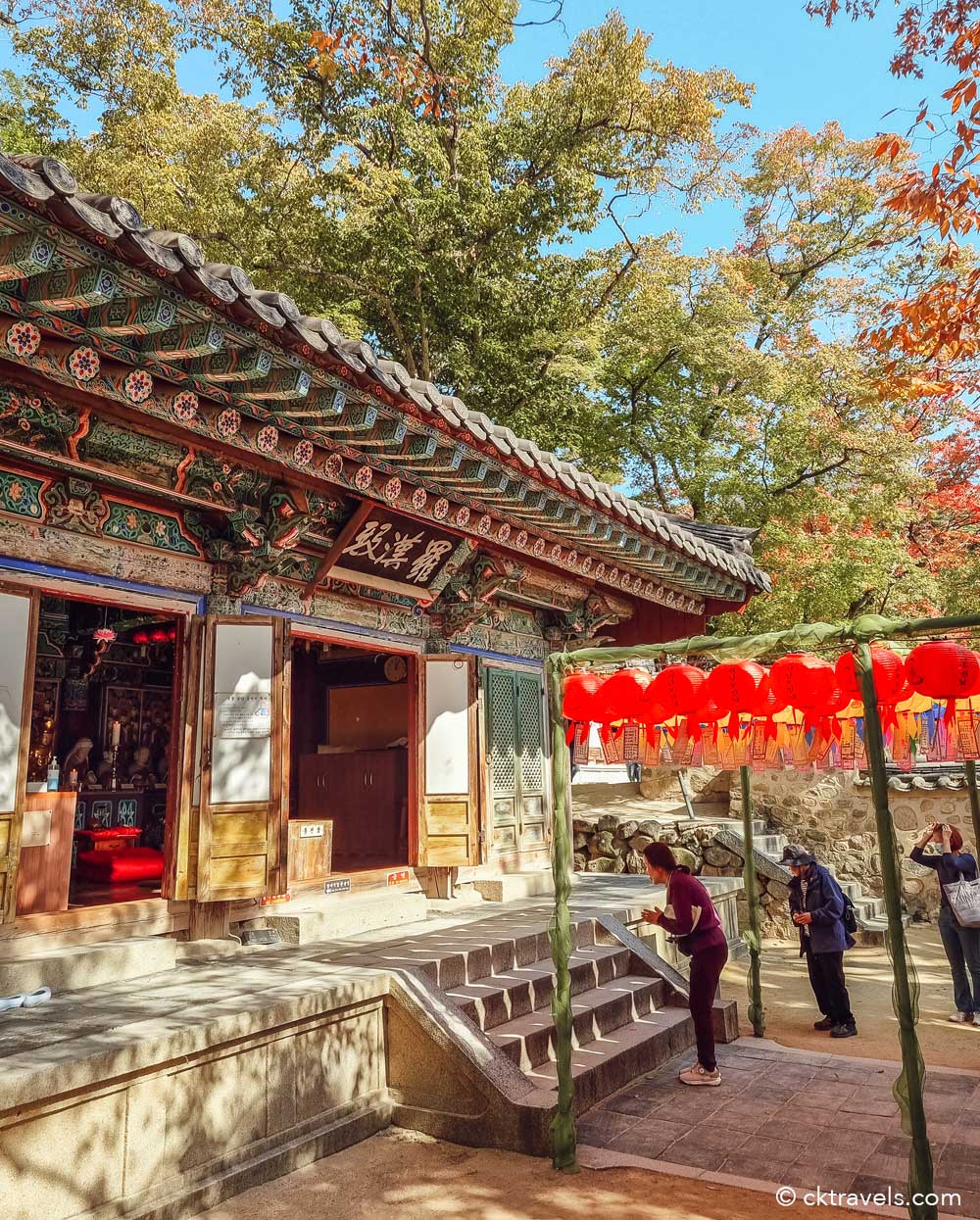
Is Bulguksa Temple worth visiting?
Overall, yes, Bulguksa Temple is worth visiting if you are spending a couple of days in Gyeongju as it is a beautiful and historic site located in a wonderful woodland setting (and free admission).
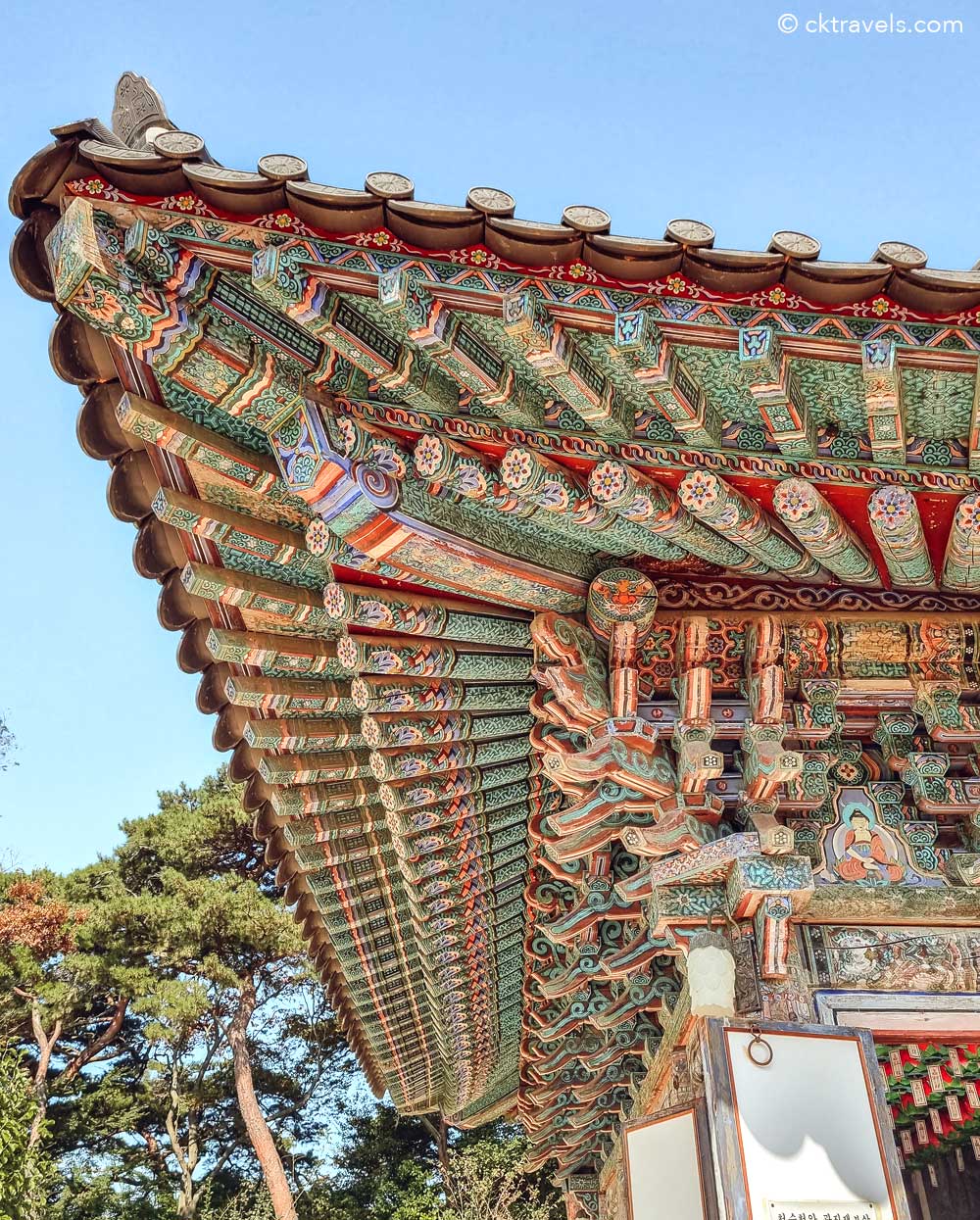
That said, it isn’t as big or ornate as some of the temples you’ll see in Japan or Thailand and the whole site can be explored in less than an hour and it gets very busy with coach groups.
Whilst we wouldn’t recommend making a special trip from say Busan or Jeonju to visit Bulguksa Temple, it is a nice way to spend a morning or afternoon whilst staying in Gyeongju.
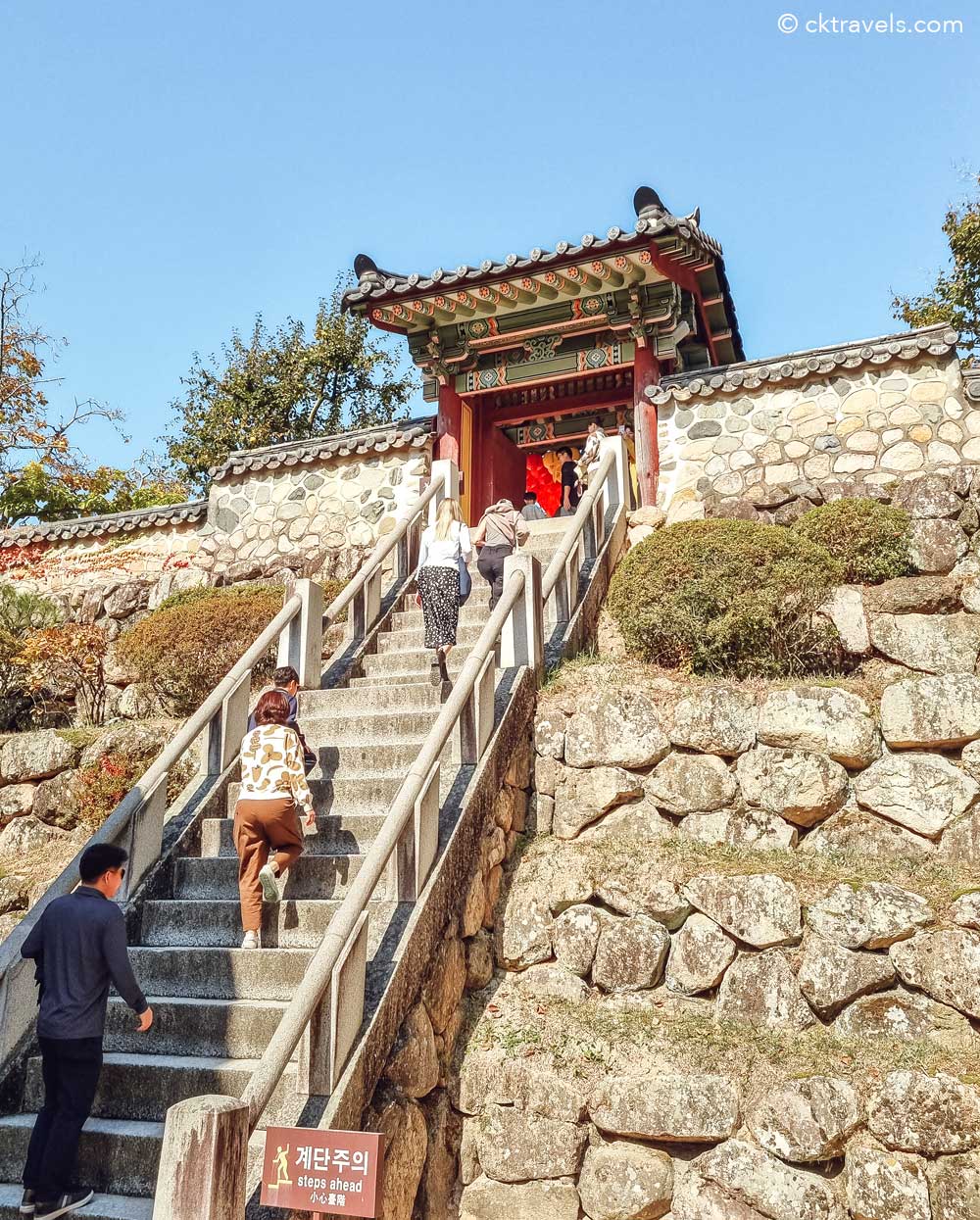
You might like – How to get from Busan to Gyeongju by bus (and how to buy tickets) >
Other things to know
- No drone photography is permitted onsite
- There are several free toilet blocks to use (many even look like mini temples with ornate tiled roofs)
- There is a tourist information centre at the entrance plus next to the bus stop where you get dropped off.
- Ample car parking is available plus lots of shops and restaurants are located across the road.
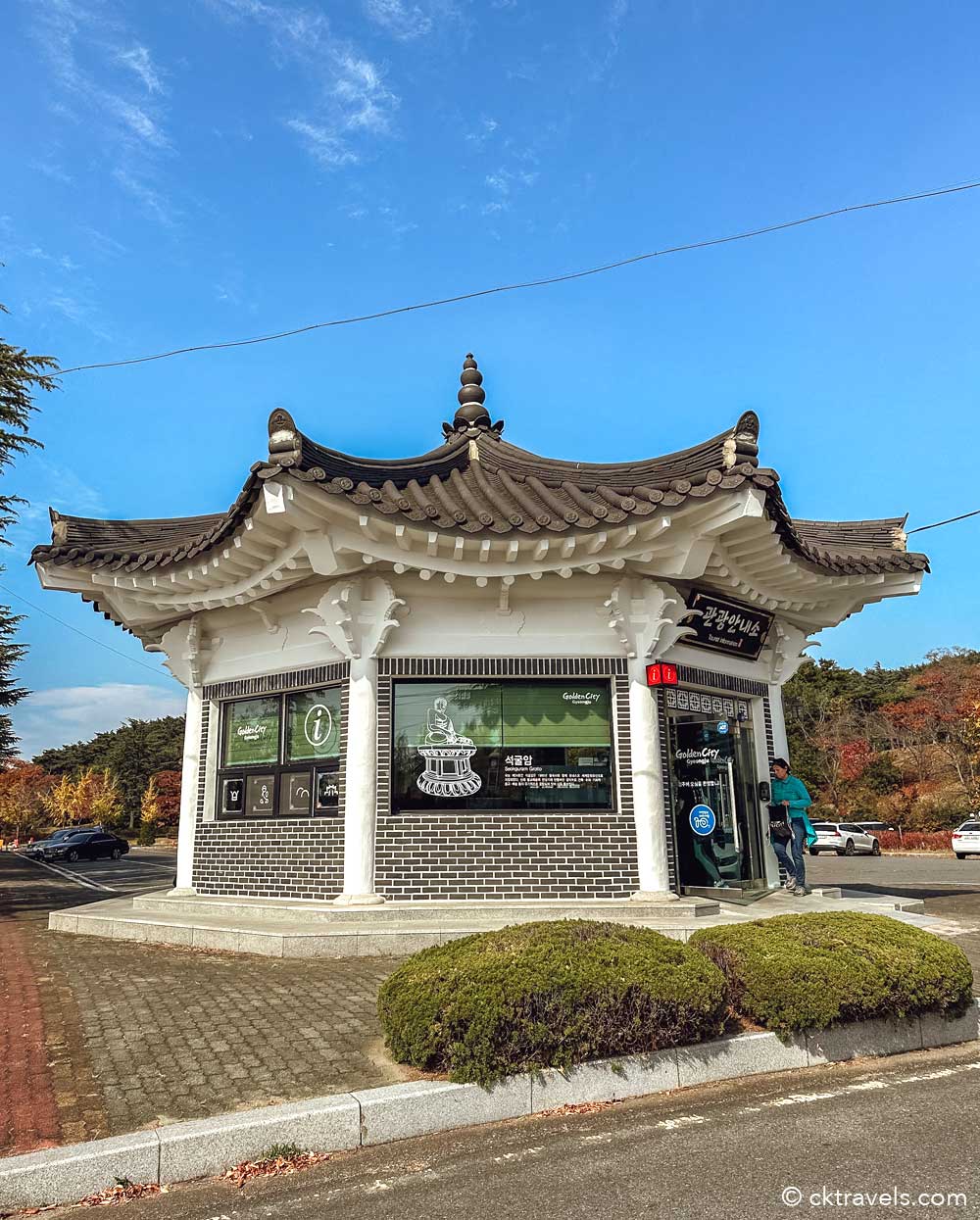
How to get to Seokguram Grotto from Gyeongju Bulguksa Temple
Many visitors combine a trip to Bulguksa Temple with Seokguram Grotto, as they are easily connected by bus.
Seokguram is a remote hillside Buddhist temple carved out of Tohamsan mountain and looking out towards the sea. Also a UNESCO World Heritage site, Seokguram Grotto was built in the 8th century.
To get to Seokguram Grotto, take bus number 12 from the opposite side of the road from the temple. The bus stop is about 10 metres on your right looking away from Bulguksa Temple, just past the Tourist Information booth.
The bus from Bulguksa Temple to Seokguram Grotto takes around 20 minutes and costs 1,700 Korean Won – price correct as of November 2023.
Bulguksa Temple to Seokguram Grotto bus timetable / schedule
The bus from Bulguksa Temple to Seokguram Grotto departs daily as follows:
- 8:40am
- 9:40am
- 10:40am
- 11.40am
- 12:50pm
- 1:40pm
- 2:40pm
- 3:40pm
- 4:40pm
Bulguksa Temple address
Bulguksa Temple, 15, Jinhyeon-dong, Gyeongju-si, Gyeongsangbuk-do, South Korea.
Other South Korea posts you might like
- Things to do in Busan, South Korea
- Best things to do in Seoul, South Korea
- Busan to Gyeongju by bus (and how to buy tickets)
- Gyeongju Gyochon Traditional Village Guide
- Best foods and drinks to try at Gwangjang Market, Seoul
- Things to do in Insadong, Seoul
- Best neighbourhoods in Seoul guide
- Things to do in Myeongdong, Seoul
- Things To Do In Hongdae Guide
- Top things to do in Gangnam, Seoul
- Seoul at Night – Top Things To Do
- Things to do in Seoul with kids
- Top Korean street foods you must try in South Korea
- Netflix knife-cut noodle lady stall at Gwangjang Market, Seoul
- Discover Seoul Pass review – is it worth buying?
Did you like our blog? Let us know in the comments below:
You can follow CK Travels on:
Instagram
Facebook
TikTok
YouTube
Pinterest

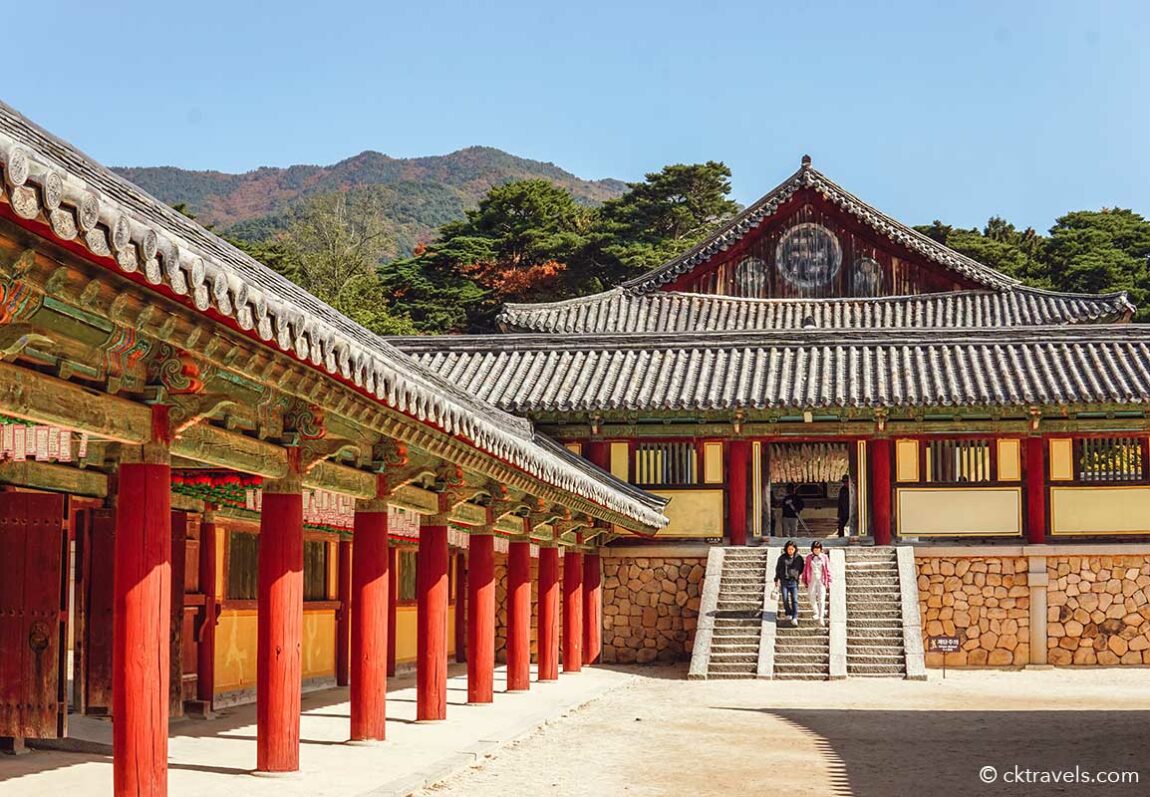
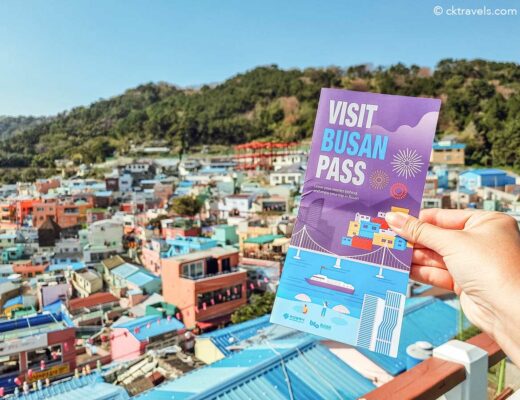
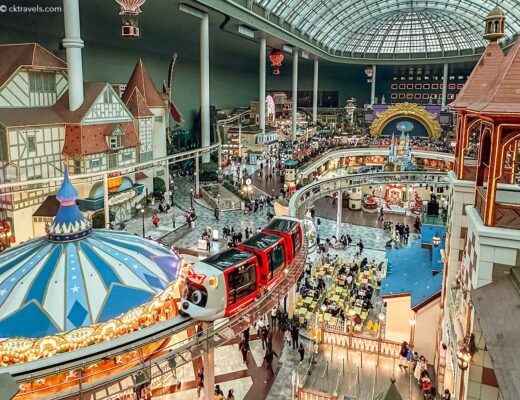
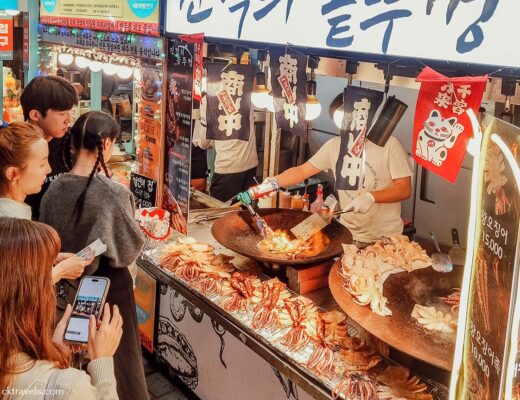
No Comments